Just starting to flower is Jeffersonia dubia, fun to watch as they emerge, the foliage is beet red and rubbery looking (Photo 1). My plants are from a good dark color form, just opening their first couple blooms... flower color is deeper than what the photo captured. However, I wanted to showcase a form that Darrell Probst collected, CPC 3.10.97 (Cobblewood Plant Collection), selected on account of it's dark flowers (although my normal form are darker) and the red seed pods. In full flower on 04-04-2010, I note some other differences: the ovary is red (green in other dubia forms) and the stamens dark tipped (light color in other dubia forms).
Sun is very strong today, and my daughter's cheap entry-level Nikon Coolpix does a terrible job with white or light-colored flowers, and after several tries, settled on these washed out looking photos, but it is the best I can do. In the last photo, I used a sun baffle to tone down the bright light.
Comments
Re: Jeffersonia
Wow, what an absolutely spectacular plant, Rick! My very modest ones have not even started to emerge yet.
Re: Jeffersonia
Thanks, Lori.
It's pretty easy to see that the dark colored stamens show up a lot better on Mark's, and in my eyes are much more attractive. I can't decide whether I like the green or the red ovaries better.
Re: Jeffersonia
I had to look for my own Jeffersonia which grows in deep shade of a conifer, and there it was but not more than an inch or two! Nice to see what comes!
Where do you grow your plants?
Re: Jeffersonia
Does anyone know of any attempts at hybridizing the American Jeffersonia diphylla with the Asian J. dubia? This year I have J. diphylla ready to bloom, with bloom time overlapping, with J. dubia, and wonder if hybrids are possible, and then again, why even try when the theoretical hybrids might inherit the bad habit of American J. diphylla blooms lasting just a single day. But now that I have two different J. dubia clones to play with, maybe I'll give it a try.
The American plant, even though flowering is ridiculously brief (1 day), is still a good garden plant; short when flowering, but after flowering the stems and foliage get rather largish to 18" tall or so, and as broad, forming a most handsome display, worth growing for the unique "twinleaf" form and the intriguing large pipe-like fleshy seed pods that open up as if a hinged pot lid.
The American species does not like disturbance, so the first photo shows a seedling plant now growing within several feet of its Asian relative. Photos 2 and 3 show the now 22-year-old clump of J. diphylla, never getting overly large in size but always showing up in a part of my woodland that is too far to reach with a hose and largely goes uncultivated. The second shot was taken today under cloud cover, the 3rd shot when suddenly the late afternoon sun shone though, giving a different aspect of this handsome woodlander.
Re: Jeffersonia
A 2009 "normal" J. dubia with a few extra petals. I like the variation of leaf form whthin the species too. I use a perhaps better quality, but still a point and shoot camera - a Lumix TZ4. It has an exposure setting I have since learned to used to my advantage for light color rendition. I'll bet the Coolpix has something similar. In fact most of my flower pics are now taken with an exposure of minus .5 to minus 1.
The second pic is the same plant today. I guess it really likes where it is. The anticipation is killing me.
Rick, your Jeffersonia really does have great "flower power". Keep a watch on your mult-petallous ones, maybe worth separating out. Mine are quite consistent, although rather darker flowered than many (I need to post some photos taken in a friends garden, where my plants came from). In most years, I forget about cleaning them up in late fall or the winter, so the mass of old stems creates a mess that can be tugged at and mitigated to some extent, but otherwise detracts from the spring flower show.
Re: Jeffersonia
My Jeffersonia dubia plants were advancing more today, thanks to another rather warm sunny day, so a couple of photos ensue. I also include a few photos from 2009, where flowering in afternoon light caught my camera's attention. Note the image dates, we're 2 weeks earlier this year than last year, also earlier than in the last 10 years. The last photo is taken in my friend's garden, Marsha Russell, a very shaded garden where the bright sun-induced red emerging foliage was not so prominent, showing lovely blue flower shades.
Re: Jeffersonia
And I thought I might be the only one attempting the cross of the two species. Thought about it last summer. Mine don't overlap bloom time, but I don't think storing the dubia pollen for the short time would be a problem. Freezing it might also be an option, as they do with Lilium pollen.
Oh if you could only see the mom of the plant I posted here. Single flowers only, but a most exquisite iridescent blue hue to the lavender. And the petals sparkle!
Regarding crossong, I have a potential problem: this J. dubia never sets seed, while my other plants do. What plant part(s) seem to be sterile, I don't know.
Re: Jeffersonia
Do you need fresh seed to get get good results or can old seed do?
Re: Jeffersonia
Do you need fresh seed to get get good results or can old seed do?
Trond, I believe the seed is ephemeral and needs to be planted shortly after harvesting.
Rick, it's too bad your special form isn't setting seed... maybe that particular plant is sterile.
My plants set lots of seed. I would always get a few self-sown seedlings, but a few years ago I started "assisting" the plant by scratching in the seed, sowing it in situ, and that has worked really well. They'll make a decent little flowering clump in 3 years. Just checked yesterday, and batches of seed are coming up... in the first photo, the just-emerging seed is within inches of the mother plant, so I assume this was not sown by me, but is just self-sown seedlings. The second photo shows a couple 2-year old seedlings, to the right of the pink Corydalis solida.
Re: Jeffersonia
I had to look for my own Jeffersonia which grows in deep shade of a conifer, and there it was but not more than an inch or two! Nice to see what comes!
Where do you grow your plants?
My garden tends to be very dry, and where I had first planted them, they just site there and flower reliably each spring, but do not bulk up, and the self-sown seedlings would germinate but few have grown on to maturity... just too dry. So, I started trying them all around the garden; they definitely appreciate good humus-rich soil and enough moisture to kept them actively growing... the foliage gets lush when grown under more favorable conditions. My gardening friend who first gave me this species, gardens under the constant shade of a grove of pines and hemlocks, where they flowered and grew well, but didn't show that beet red new growth as they do when they're grown in a deciduous woodland and get lots of spring sunshine.
Re: Jeffersonia
When I get more plants I have to try different places! The one I have now grows under a dense hemlock but I have broadleaved trees too. The soil consist of almost pure humus. Can be dry in May and June but I very seldom use a hose to water the plants.
Re: Jeffersonia
So, has anyone tried crossing the two Jeffersonia species, the North American J. diphylla and the Asian J. dubia? Both are easy growers, but long appreciated that the Japanese (and from other Asian countries) is the better of the two species, being more showy with longer lasting blue flowers. Has anyone attempted crosses between the two species?
This year, being the earliest spring on record here in Northeastern USA, with a current heat wave accelerating the season, both species are in bloom at the same time, a rare occurrence. So what to do... try hybridizing, what else? Does anyone know of any success in hybridizing these two species? I certainly dabbed pollen both ways today, given the rare occurrence of both blooming at the same time. We'll see what transpires in a few years.
Also today, I spied some seedling plants of J. diphylla in a woodland area of my property well beyond the reaches of water hoses, and I was struck by the dark blackish coloration of the leaves on some J. diphylla seedlings; photos show this coloration. They are yet to bloom, so I still have about 2 days of Jeffersonia hybridization opportunity available. Hey Aaron, what sort of variation have you spotted on this plant?
Re: Jeffersonia
Wow, I must have not so worthy diphylla genetics, or else you have really nice ones, Mark. Or is it just all the rain you've been getting?
These are the blooms on mine from last year. While J. dubia in the same garden is blooming now, J. diphylla is only five inches high.
Re: Jeffersonia
Wow, I must have not so worthy diphylla genetics, or else you have really nice ones, Mark. Or is it just all the rain you've been getting?
These are the blooms on mine from last year. While J. dubia in the same garden is blooming now, J. diphylla is only five inches high.
Rick, your plant looks like many do... with space between the petals. Never really thought about my plant being anything different or special, but Twinleaf is rather variable based on photos I've looked at (see photo links below). In my plant, the petals overlap for a fuller looking flower.
Not sure where I got my plant originally, had it when I was a boy, at age 10 I started a wildflower garden, and most likely bought my plant at a local nursery. When I moved to my current location 23 years ago, I dug up lots of plants still growing in my old gardens at my parents house, so my plant sources all the way back to my original plant. The plant in my photograph, has been in the same spot for those 23 years :o :o... talk about longevity! In all those years it hasn't seeded around much, just in the last few years has it started to spread. I upload a photo taken yesterday, still looking good (even though I took off a few flowers, to use as pollen material for attempted crosses), and a photo of a young seedling. Now that I train my eye looking for seedling plants, I'm finding them all over the place.
Around midday (noon) the pollen on both species is ripe and ready. I dabbed pollen of dubia onto diphylla (easy to see the purplish pollen on the yellow stigma) and I tried the reverse cross as well. I'll let you know in about 4 years whether I get hybrids ;D
Four pages of photos showing Jeffersonia diphylla, some flower variability, but the leaf shape and size vary dramatically. And I love the seedpods, some photos here.
http://www.flickr.com/search/?w=all&q=%22Jeffersonia+diphylla%22&m=text#...
(By the way folks, using Flickr photo searches is a fast way to find photos of plants one is interested in seeing. Mind you, there will be some misidentifications, such as a few J. dubia showing up as diphylla. Use "Search - Everyone's Uploads" then put quotes around the plant botanical name as the search criteria.)
Cute little one, distinctively cut leaves
http://www.flickr.com/photos/sklockwood/4158868636/
Image of J. diphylla BONAP Distibution Map
Re: Jeffersonia
Hello all,
I've been thinking about moving my Jeffersonia dubia, only because it is under a Rhododendron that is beginning to cover it too much and it isn't so visible anymore, although it still seems happy where it is. I've also wondered about dividing it when I move it. Is this advisable and if so, when would be the best time?
Re: Jeffersonia
Hello all,
I've been thinking about moving my Jeffersonia dubia, only because it is under a Rhododendron that is beginning to cover it too much and it isn't so visible anymore, although it still seems happy where it is. I've also wondered about dividing it when I move it. Is this advisable and if so, when would be the best time?
Hi Paul, welcome to NARGS Forum!
I received my plants from a friend who was closing her nursery; she had gobs of Jefferesonia dubia and we dug them in late summer or early fall, then I literally sliced into the very dense mats of roots to separate them, and they did just fine. However, my guess is the best time to move any spring ephemeral is in early summer, well after the plant has flowered and had time to set seed, then divide, replant, and water well to re-establish them before fall/winter. Jeffersonia dubia seeds around like crazy, always wondered why the plant is considered such a high-priced specialty, when it is so ready to reproduce itself. Seedlings can be moved any time to semi-shady spots and they'll do just fine.
Re: Jeffersonia
Indeed your foliage is different than mine also.
Rck, your largely untoothed Twinleaf plants has me thinking, I must increase my Twinleaf form representation here, to start getting a wider range of forms. The leaves on your plant are not dentate as they are in mine, more of the classic "Twinleaf" form. Again, this is the fascinating aspect of growing plant species, so much variation, often moreso than one imagines.
Re: Jeffersonia
I've never had a need to divide any Jeffersonia (but maybe this year), but I do transplant mature seedlings regularly from our Arboretum garden for our Chapter sale. Because of convenience, I transplant after they bloom and leaves are mature. They weather the transplanting just fine.
BTW, my best tool for dividing plants is one of those Ginsu knives that are never supposed to dull. It's true! I bought it at a garage sale, just to try, and after years of use, it still cuts through soil and plant rhizomes/tubers/roots like butter. It is the cat's meow for trimming soil balls to fit into pots for the Chapter plant sale. If I ever lost it, I would definitely go out and buy another.
Re: Jeffersonia
BTW, my best tool for dividing plants is one of those Ginsu knives that are never supposed to dull. It's true! I bought it at a garage sale, just to try, and after years of use, it still cuts through soil and plant rhizomes/tubers/roots like butter. It is the cat's meow for trimming soil balls to fit into pots for the Chapter plant sale. If I ever lost it, I would definitely go out and buy another.
Thank Rick, maybe I should get a Ginsu knife for slicing up Epimedium, they're an absolute bear to divide, the rhizomes grow so dense and tough.
Re: Jeffersonia
Thank Rick, maybe I should get a Ginsu knife for slicing up Epimedium, they're an absolute bear to divide, the rhizomes grow so dense and tough.
Definitely! Try to get with the longest and least flexible cutting blade available.
Re: Jeffersonia
No sign of my dubia yet.....mine is a deeper blue version than any of the ones shown. A pic from 2 years ago.
Re: Jeffersonia
This was nice, Todd! Have to try hard to get hold of different colors of Jeffersonia.
Re: Jeffersonia
I looked at my three pods of clean crosses of Jeffersonia dubia x J. diphylla. They may have taken since they have not withered and feel solid. However they are consistently three-quarters the size of normal pods. I am very hopeful.
Re: Jeffersonia
I looked at my three pods of clean crosses of Jeffersonia dubia x J. diphylla. They may have taken since they have not withered and feel solid. However they are consistently three-quarters the size of normal pods. I am very hopeful.
Are you prepaired to do embryo rescue if necessary? Maybe they have to little endosperm.
Re: Jeffersonia
No, I am not prepared to do ER. I am hoping the smaller pods are just due to less efficient fertilization and fewer seeds, rather than smaller seeds.
Re: Jeffersonia
No, I am not prepared to do ER. I am hoping the smaller pods are just due to less efficient fertilization and fewer seeds, rather than smaller seeds.
Rick, we're on parallel efforts here. On my plant where I attempted Jeffersonia dubia x J. diphylla, the four pods the pods look normal sized I suppose, but then again, I did not compare their size to regular J. diphylla elsewhere in the yard. Same with the pods on a plant I dedicated to trying J. dubia x diphylla :D
I have been doing some garden visits recently, and invariably both species are being grown, and I find the leaf and plant variability interesting me, to the point I'll ask for seed from some of the various sorts, to increase the gene pool. The first photo is a pod on my attempted Jeffersonia dubia x J. diphylla, and the next two photos are a good looking leaf form in the garden of Peter George's fine garden in Central Massachusetts.
Re: Jeffersonia
I see you used J. dipylla as the pod parent, Mark. Did you also do the reciprocal cross? I only did J. dubia x J. diphylla, but left open pollinated pods attached on the same plant. I decided I didn't want the ants eyeing my prize pods as the only ones available for ravaging. This way, if I miss the initial ripening, there is a good chance my special pods will be left alone long enough for me to harvest them.
Re: Jeffersonia
I see you used J. dipylla as the pod parent, Mark. Did you also do the reciprocal cross? I only did J. dubia x J. diphylla, but left open pollinated pods attached on the same plant. I decided I didn't want the ants eyeing my prize pods as the only ones available for ravaging. This way, if I miss the initial ripening, there is a good chance my special pods will be left alone long enough for me to harvest them.
Yup, I tried the cross both ways... anxiously awaiting seed pods to ripen. Meanwhile I've been very busy with trying to stay ahead of ripening Epimedium seed. I used approx. 25 different epimediums on which I hand pollinated each and every flower over a period of weeks, plus I'm sowing seed of some open-pollinated varieties I'm interested in, as they will hybridize with their eppie neighbors. It's like shucking peas in miniature, squeezing out the little green bean-like seeds. Have to cover the seed flats with fine wire mesh, as any flat left out becomes prime romping digging grounds for chipmunks. After sowing my first 6 flats, intending on protecting the flats the following day... too late, chipmunks already went crazy with digging them up! I anticipate similar sowing process for the Jeffersonia, direct fresh sowing of seed into peat flats, which will remain shaded and kept mildly moist all summer and left out all winter, hopefully for spring germination.
Re: Jeffersonia
Seed pods on Jeffersonia dubia started shedding today, time to harvest and sow. :D
Re: Jeffersonia
Seed of my attempted Jeffersonia diphylla x dubia cross were harvested and sown on May 30, 2010 (see first photo).
Interestingly, seed of regular Jeffersonia diphylla down in the wild shady woodland part of my property only just ripened today, fully 5 weeks later! Photos 2-4 show the seed harvest which is being sent to seed purveyor Kristl Walek in Canada. There is nothing easier (and more fun) than the "pop and pour" seed cleaning on Jeffersonia. The seeds cannot be dried out, so they will be packed in barely moist vermiculite in a plastic zip-lock bag.
Re: Jeffersonia
You give your seeds a worthy start, Mark, feeding them with chocolate cake!
Re: Jeffersonia
Really nice plump pods, Mark. And gosh, there is enough to eat (if they were edible)! I hadn't even thought of chocolate cake, LOL, but they remind me of wheat berries.
I had done three clean crosses of J. dubia x J. diphylla, with the stigma protected from before the petals opened and after hand pollination. As what seems to often happen, I was watching, waiting, watching, waiting ... checking every day, and then some urgency comes about, and I don't check for several days. Two of the pods had opened and released all their seed. :( Just yesterday, I had checked the third, gently squeezing to see if it would pop. Not yet.
But today it did and below is the result: three "seeds."
-- One small, flat (empty) and off color.
-- One small, fairly plump, but obviously not developed as it should be.
-- One normal size, and looking very viable! A fitting Birthday present, as this is mine and Donald Duck's special day.
Maybe I didn't have to wait until the pod pops with a squeeze. It had already turned whitish for several days. What do you think, Mark (or anyone)?
Re: Jeffersonia
First of all, Happy Birthday! Mine is coming up this Sunday, yay geminis.
Too bad Rick, on missing most the seed; hate when that happens. The pods on Jeffersonia don't look hardly any different when they're approaching readiness (turning whitish) and when they are ready. I've been going out every day for the last two weeks, giving the pods a gentle squeeze near the top, and just three days ago, a couple gave a slight pop and the seam between the "lid" and main body of the pod separated... I could see the browning seeds inside. I left them a few more days, checking each morning, but this morning when trying my second test for readiness; a slight bend on the pod, the pods readily detached when barely touched, so all seed was harvested. However, I could have harvested the seed sooner, when the lid seam on one or two pods pops under gentle pressure.
I was similarly waiting on Jeffersonia dubia seed (regular open-pollinated seed), and dang these things suddenly ripen and start spilling without much warning, must have missed 30-40% of the pods, but still collected enough to sow a 3' x 4' patch in the garden for a lollapalooza of seedlings next spring, if the chipmunks, squirrels, and mice don't get them first.
Never having grown Iris cristata from seed, I have been checking developing pods every few days by picking a green pod and breaking it in half... the green pods don't look very different than 4 weeks ago, but today the seed looks like it is now firm enough and viable. And with Iris koreana seed I showed on another thread, the ready pods are very green... the only way to tell for readiness is size (they get big) and sampling one, breaking it in half to see what the seeds looks like inside. I believe I have some Trillium seed ready too... a friend of mine who grows lots of trillium from seed with high germination, tells me to harvest before they are visibly ripe and spilling... I guess it requires a knack of knowing when such things are ready... again, the benefits of being unemployed is having time to putter around in the garden every day.
Re: Jeffersonia
Thanks for the well wishes, Trond and Mark!
Mark, neither my J. diphylla or J. dubia pods ever detach from the stem. As they open, the stems bend at the base, allowing each stem and pod to lay horizontally on the ground.
I lost my Trillium luteum seed last year by waiting too long. The pod was so plump and promising, but one day I went out and a hole had been cut in the pod wall, and every seed removed.
I have always waited for iris pods to change color and begin to crack before harvesting. Never had a problem with seed theft. Should I be gathering earlier? Is there a distinction between beardless and bearded iris n this respect?
Re: Jeffersonia
I have always waited for iris pods to change color and begin to crack before harvesting. Never had a problem with seed theft. Should I be gathering earlier? Is there a distinction between beardless and bearded iris n this respect?
I think the method of harvesting Iris seed can be different depending on species and on section within the genus. For dwarf bearded Iris, like the two fat pods I have on I. suaveolens, I'll let the pods crack open. On Iris koreana and henryi, in years past I never got seed... waited too long and something always got to them first, the seeds are ripe and ready when the pods are green, so this is the first year I got lots of seed on both and sowed them straight away. Now I'm still testing Iris cristata pods... lots of plump pods, but its a learning experience for me, I have never collected seed on I. cristata varieties before, never a need because they're so easy to just divide up... but now being interesting in hybrid variations, I want to try sowing and germinating the seed. Tested the pods again today, they're close to ready, but I'm still waiting a few more days.
Re: Jeffersonia
I recently visited the garden of George Newman in southern New Hampshire, an extensive naturalistic garden and haven for approximately 800 species of native plants. There were dozens of large patches of Jeffersonia diphylla throughout his woodlands, each patch 9' (3 meters) or more across. It turns out, there were colonies representing two leaf forms, both from seed he collected near Syracuse, New York, many years ago. Unfortunately, I did not get photos of his more predominant form, a low growing one a foot tall or less, with rather smallish saw-tooth paired leaves... cute and different from my robust plants that can be 2' tall (or more) x a 2-1/2' spread (60 cm x 75 cm wide) in mature clumps.
What really caught my eye, was a second leaf form, just a bit taller, with strongly 3-lobed leaves, of with the top lobes on the paired leaflets overlap, giving a rather distinct look. I uploaded 3 photos showing this leaf form. Excuse the darkness of the photos, the skies were heavy with thick clouds and rain. Most seed pods had been broken into by animals that apparently eat the pods, but I was allowed to harvest any pods intact, of which there were several pods from each form. It'll be interesting to increase one's gene pool of this unique and lovely wildflower.
Re: Jeffersonia
Wow, Mark, that's pretty spectacular!
Re: Jeffersonia
2' tall? My Jeffersonia never exceeds 1/2'!
These leaves are very different from anything I have seen (but I haven't seen much of Jeffersonia!). It seems to be moist where they grow?
Re: Jeffersonia
2' tall? My Jeffersonia never exceeds 1/2'!
These leaves are very different from anything I have seen (but I haven't seen much of Jeffersonia!). It seems to be moist where they grow?
It was very moist (wet in places) in George Newman's garden, yet his Jeffersonia clones only reached 12" or so. My plant that reaches 24" tall is growing in dry open woodland under moisture-wicking sugar maples. There is lots of genetic differences in leaf size, shape, and plant height; little has been done about selecting different forms although I know of one start-up nursery that has two J. diphylla selections on their list (but because their list was "provisional" or a preview, I'm not allowed to divulge).
Re: Jeffersonia
It was very moist (wet in places) in George Newman's garden, yet his Jeffersonia clones only reached 12" or so. My plant that reaches 24" tall is growing in dry open woodland under moisture-wicking sugar maples. There is lots of genetic differences in leaf size, shape, and plant height; little has been done about selecting different forms although I know of one start-up nursery that has two J. diphylla selections on their list (but because their list was "provisional" or a preview, I'm not allowed to divulge).
Interresting! I have always thought of Jeffersonia as rather small plants with size like Hepaticas!
Re: Jeffersonia
I have received fresh seed of the white form of Jeffersonia dubia, which is being grown and shown in the UK, and with luck, I'll get germination and in a few years have this gorgeous white form here in the USA.
http://www.srgc.org.uk/smf/index.php?action=dlattach;topic=5303.0;attach...
Re: Jeffersonia
That is something to crave!
Re: Jeffersonia
Fascinating discussion and photos! I look forward to updates on these seed projects. Though out of season, here are some photos of J. dubia. They were taken this past spring at Hantaek Botanical Garden, an hour or two southwest of Seoul.
Gorgeous Jeffersonia clumps there. Do you have more photos of Korean plants to share with us on the forum sometime? During the winter months, or any time for that matter, it is perfectly fine to show plants not current with the date of posting. Do you grow both Jeffersonia species in Tennessee? I'm sure J. diphylla is native where you are, have you found much variation in this species?
Re: Jeffersonia
Fascinating discussion and photos! I look forward to updates on these seed projects. Though out of season, here are some photos of J. dubia. They were taken this past spring at Hantaek Botanical Garden, an hour or two southwest of Seoul.
This is exactly what I want in my garden. How do I accomplish that??
And I join Mark, I am ready to digest more pictures from Korea.
Re: Jeffersonia
This is exactly what I want in my garden. How do I accomplish that??
And I join Mark, I am ready to digest more pictures from Korea.
Trond, I believe the seed is ephemeral and needs moist packing. I sent seed to people in the UK (small moist packed), I could send some next year in the spring 2011 harvest, but you'll have to remind me. :D
Re: Jeffersonia
This is exactly what I want in my garden. How do I accomplish that??
And I join Mark, I am ready to digest more pictures from Korea.
Trond, I believe the seed is ephemeral and needs moist packing. I sent seed to people in the UK (small moist packed), I could send some next year in the spring 2011 harvest, but you'll have to remind me. :D
Very kind of you, Mark. I don't think I'll forget to remind you!
Re: Jeffersonia
I do have more photos of plants in Korea, both in cultivation and the wild. I'll make a few posts along those lines.
Trond, I know that the botanical garden is irrigated and watered regularly, and also the Korean peninsula is under the influence of summer monsoon, which means plenty of moisture during some of the hottest months. Presumably even when the plants' vegetative growth is dormant they benefit from not drying out completely. Other than that I don't know, but they are propagated from local/native stock so that probably helps too.
Mark, I only have J. diphylla at present, though it is certainly not because I don't want to grow J. dubia! It's just pure laziness or a lack of making it a priority. :-[ It's among several 'must haves' that I should make a priority very soon. J. diphylla grows near the garden naturally, and my plants are sourced from those colonies. I haven't given much attention to variation but will make a point to look closer next spring.
Re: Jeffersonia
Stunning clumps of Jeffersonia everyone. I grow both dubia and diphylla here, but haven't had the guts to try them out in the ground much yet as they're so rare here. I've had a few flowers on the dubia and only a single flower so far on diphylla. I hope to one day flower them well as a clump, but in my climate I think I am probably going to battle to do it. Thank you all so much for the wonderful pics.
Re: Jeffersonia
If anyone can spare some fresh seed of J. dubia, I would love to grow some. Please send me a personal message. Thanks.
Re: Jeffersonia
If anyone can spare some fresh seed of J. dubia, I would love to grow some. Please send me a personal message. Thanks.
Hi Gene, I'd be happy to send you some when they're ready. The seed is ephemeral and should be sown shortly after the late spring harvest. But if you depend on me remembering to send seed, it'll probably never happen, so feel free to send me a reminder message to me in late May to early June. I also recommend putting your Jeffersonia dubia seed request in the Plant and Seed Swap topic, that way it won't be lost among a general topic :)
http://nargs.org/smf/index.php?board=70.0
Re: Jeffersonia
Really nice looking plants! Not a genus I've seen much of--just the occasional mention on the forums, but after seeing Joseph's pics from Korea, I had to go back and look at the whole thread..
I'm curious to see which species Lori is growing?
Re: Jeffersonia
Depending on one's taxonomic outlook, there are only two species, American J. dyphylla and Asian J. dubia. However, the name of the Asian species was changed to the ugly name of Plagiorhegma dubium (sounds like a skin disease), leaving Jeffersonia and Plagiorhegma each as monotypic genera.
Re: Jeffersonia
the name of the Asian species was changed to the ugly name of Plagiorhegma dubium
Not liking that.
I guess that shows that our attempted (now generic) crosses all the less likely...
Re: Jeffersonia
the name of the Asian species was changed to the ugly name of Plagiorhegma dubium
Not liking that.
I guess that shows that our attempted (now generic) crosses all the less likely...
According to Darrell Probst, the cross between the two species if perfectly possible, and has been done, but I know of no particulars. These plants may not care about the human-imposed nomenclature genus shift. Time will tell ;)
Re: Jeffersonia
I'm curious to see which species Lori is growing?
I have a couple of Jeffersonia dubia but (the plant formerly known as :rolleyes:) J. diphylla is also hardy here. I thought I had acquired it once but it turned out I'd bought another J. dubia. (Doh!)
EDIT: Ooops, I got that backwards... it's J. dubia that I will have to relabel in all my records!
Re: Jeffersonia
So, 2 more to add to the list then...lol
Re: Jeffersonia
Jeffersonia are awakening, ready to flower. A bit too overcast, cold and windy for the blooms to open, but maybe in another day or two. On the left is J. diphylla with ephemeral emergence in fleshy red-purple tones, and on the right, the Korean form of J. dubia with even deeper ruddiness and rich lavender flowers held closed from the cold.
Re: Jeffersonia
Beautiful, Mark, both of them!
Re: Jeffersonia
Beautiful, Mark, both of them!
Thanks Trond, these are nice plants that I'm particularly fond of. I also like their early flowering, blooming at the same time as Corydalis solida and Pulmonarias, both of which have started.
A few more views on this relatively mild sunny (but windy) early spring day, a State holiday in Massachusetts (Patriot's Day, and the running of the Boston Marathon). Thought I'd share a few more photos, as I have to wait until next weekend to see them again.
Two views of the Korean form of J. dubia, in the second photo you get a peek at the red ovaries (typically they are yellowish green).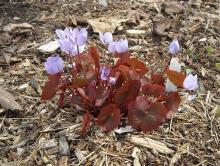
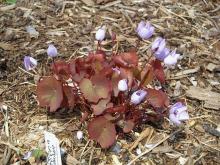
Two view of regular J. dubia, although my plants came from a friend and nearby gardener Marsha Russell, who had some darker colors. Today, the first flowers actually opened.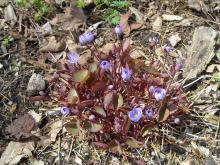
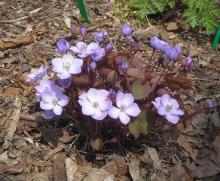
A small grouping of Jeffersonia diphylla in my woods. I fear I shall miss their fleeting 1-3 day bloom period this year, now that I'm back to working.
Re: Jeffersonia
Gorgeous, Mark!
I'm a latecomer to awareness of these plants, but find them very charming indeed!
On the subject of spring ephemerals, does anyone know of a seed source for this sort of thing? (woodlanders, spring things etc) Kristl has some ephemerals, and we know her methods are reliable..... any others that aren't simply people selling seed of doubtful validity in fall/winter?
Re: Jeffersonia
If you have some surplus seed, Mark.........
Re: Jeffersonia
I typically have lots of seed of both species; happy to share moist-packed seed which must be sown upon receipt.
Re: Jeffersonia
Hi Mark: Could you please add my name to the list for Jeffersonia dubia seed? I too have J. diphylla and have been admiring its slow motion and eye catching emergence and will probably have plenty of seeds to give away when the time comes. I expect J.dubia seed could be planted nearby - would have same requirements as to soil and exposure? Fran Howey
Frances Howey
London, Ontario, Canada
Zone 5b
Re: Jeffersonia
Hi Mark: Could you please add my name to the list for Jeffersonia dubia seed? I too have J. diphylla and have been admiring its slow motion and eye catching emergence and will probably have plenty of seeds to give away when the time comes. I expect J.dubia seed could be planted nearby - would have same requirements as to soil and exposure? Fran Howey
Frances Howey
London, Ontario, Canada
Zone 5b
Sure thing Fran. And yes, the two species like similar habitat, although the American J. diphylla will sail through more drought than J. dubia. I haven't lost any J. dubia to drought, but the leaves tend to collapse much more easily in dry weather than diphylla.
Re: Jeffersonia
I typically have lots of seed of both species; happy to share moist-packed seed which must be sown upon receipt.
;D ;D ;D
Re: Jeffersonia
I planted some J. dubia seed from the NARGS (received 1/11, lot #1694) on 3/20/11 in an unheated greenhouse. This was moist-packed seed. It is germinating now (4/21/11). I did not give it an initial warm period. I assumed the moist packing took care of that. Temperatures varied from 32F at night to 70F during the day.
This seed has very erratic germination. I have some that are germinating two years after being sown. It may have something to do with whether the seed has been dried.
Re: Jeffersonia
I planted some J. dubia seed from the NARGS (received 1/11, lot #1694) on 3/20/11 in an unheated greenhouse. This was moist-packed seed. It is germinating now (4/21/11). I did not give it an initial warm period. I assumed the moist packing took care of that. Temperatures varied from 32F at night to 70F during the day.
This seed has very erratic germination. I have some that are germinating two years after being sown. It may have something to do with whether the seed has been dried.
Gene, I think you're right about the seed being dried creating the condition of erratic germination. I believe the seed is best treated as ephemeral, like Epimedium, needing to be sown "in the green" as soon as the seed is ripe, then one gets fairly uniform germination the following spring after a long winter freeze. Last year, as an experiment (and as a desire to greatly increase my Jeffersonia stock), in late spring 2010 I collected gobs of J. dubia seed, then made a new planting area in my shady woodland garden beds, an area 4' wide by about 4-1/2' long, and sowed J. dubia seed thickly through the area. The seed was patted down on the soil, and covered with a thin layer of well decomposed pine bark mulch. I checked today, and the area is thick with seedlings just emerging, I'm so excited. There will many hundreds (thousands?) of plants. I'll post some pics as soon as the seedlings get large enough to be photographed.
Re: Jeffersonia
Hard not to fixate on Jeffersonia, they're in their prime at the moment, most J. dubia in full bloom, but a few flowers on J. diphylla opening too. Here are a few more photos of J. dubia. In one view, you'll see that the forms I have are variable in flower color, some are of a good deep blue-lavender color.
One more view of a Korean form of J. dubia. This form flowers before the others, and has flowers that are more fleeting. Notice a self sown seedling on the left and bottom edges of the photo.
Re: Jeffersonia
Beautiful, Mark :)
Re: Jeffersonia
Gorgeous, Mark!
Congrats on the new seedlings! a big patch would be wonderful :)
Re: Jeffersonia
So pretty Mark! Mine are just showing above soil...but just the promise of them is so exciting! Have you ever divided them? I would love to make my small swath of them a large one ;D
Re: Jeffersonia
Given the rain we've had, I'm amazed that I've been able to get any pictures of anything for the past week of so, but I did manage a decent of my J. dubia and one of my J. diphylla just about to open. Hopefully it won't rain tomorrow, and the latter beauty will open its flowers for long enough for me to take a picture or two. I've had the J. diphylla for about 5 years, and it's got about 5 or 6 seedlings growing around it, one of which actually bloomed this year. The J. dubia has been with me for 3 years, and has yet to produce any seedlings.
[MMcD note: photo labels were reversed, I downloaded and re-uploaded the renamed photos :)]
Re: Jeffersonia
Mark and Peter the diphylla are really lovely,I have only seen white ones over here,never blue similar to dubia. The Epimedium book gives them as only white.
Tony, see the correction above, the photo names were reversed, but it has been fixed :) Jeffersonia diphylla only comes in white, but I'm currently getting good germination on my attempted 2010 hybrid crosses between the two species (both ways), who knows, maybe we'll eventually see a blue diphylla-like Jeffersonia ;D
Re: Jeffersonia
Thank you, Mark. The rapid and profound diminishment in my cognitive processes is worrisome, but hopefully will end when I get through this negotiation and manage to sell my company. A bit of sun might help too.
Re: Jeffersonia
Oh dear Mrs W. and I were getting very excited and an email was about to wing its way across asking for seed. We shall manage to live with our disappointment.
We look forward to seeing the hybrids.
Re: Jeffersonia
With ephemeral spring flowers a lot can change in just 1 week. Our spring was slow to warm up this year, but in the past week with mild temperatures and rain, and some very warm sunny days, plants are "leaping" out of the ground. I also realize, now that I'm back to being a working man (as opposed to unemployed), that I would have never have had the chance to experience the fleeting flowers on Jeffersonia as I did last year, nor would it have been possible to play around with attempting to hybridize the two species.
A couple Jeffersonia garden views, J. dubia in the first, J. diphylla in the second. Lots of Dicentra cuccularia spreading everywhere; am getting worried about this one.
Two views of Jeffersonia diphylla, photos caught in an early morning dash before going to work.
Last year I collected lots of seed on J. dubia, prepared an area approximately 4' x 5', and sowed the seed in place, covering with a thin layer of decomposed pine bark mulch. The seedlings are coming up thick now. As it is, seedlings are appearing here, there, and everywhere, what a wonderful "weed" to have ;D
Spring 2010 I also made crosses between J. dubia x diphylla, and the reverse, J. diphylla x dubia. Seed is germinating. First up, are J. dubia and the attempted cross... I have four flats of putative J. dubia x diphylla hybrid seedlings. I also show a photo of two forms of J. diphylla germinating... this species germinates a bit later, so still waiting to see if any J. diphylla x dubia, and waiting for J. dubia alba to show.
Re: Jeffersonia
I am looking forward to hear of the achievements of the crosses, Mark!
Re: Jeffersonia
It is interesting to note (for those who haven't already) in Mark's photos, that because Jeffersonia seed is hypogeal germinating and establishes a root system before topgrowth, the first leaf to emerge is a true leaf, and not a cotyledon. It make them especially cute. :)
Re: Jeffersonia
Very interesting, Rick. I would never have realized that!
The state of J. dubia in my yard... finally above ground!
Re: Jeffersonia
My J. dubia are in a race with yours Lori! Mine look neck-in-neck to yours. I purchased a diphylla this year but it was from BC so the flowers are lomng gone. Still, I hope next year I can make a cross as you did Mark...I expect the hybrids would be lovely!
Re: Jeffersonia
Seed scrounger here. Can anyone spare a few?
Re: Jeffersonia
Seed scrounger here. Can anyone spare a few?
Sure thing... post a reminder in about 1 month, seed of both species should be ready. :)
Re: Jeffersonia
Well, I missed the bloom on Jeffersonia dubia, among other things...
This is all I got to see! Oh well, there's always next year... :rolleyes:
Re: Jeffersonia
Well, I missed the bloom on Jeffersonia dubia, among other things...
This is all I got to see! Oh well, there's always next year... :rolleyes:
Lori, at least you have some good pods developing... collect the seed and sow around the base plant immediately after harvest, and next year you too could have a carpet of seedlings showing next spring! My sown-in-place seedlings are growing fast, cute little babies by the hundreds, some could actually bloom next year.
Re: Jeffersonia
Wow, won't that be a show at your place!!
I will definitely do that.
Re: Jeffersonia
Wow, won't that be a show at your place!!
I will definitely do that.
My ultimate plan is to replace a major portion of my lawn with Jeffersonia; a Jeffersonian landscape (with both species) ;D
(and I'm not kidding!)
Re: Jeffersonia
Wow, won't that be a show at your place!!
I will definitely do that.My ultimate plan is to replace a major portion of my lawn with Jeffersonia; a Jeffersonian landscape (with both species) ;D
(and I'm not kidding!)
And you will invite us to the opening display, please? ;D
Re: Jeffersonia
My ultimate plan is to replace a major portion of my lawn with Jeffersonia; a Jeffersonian landscape (with both species) ;D
(and I'm not kidding!)
That might actually work well. I have noted how massive Jeffersonia diphylla roots are compared to the plant, and I think they would be integral in keeping other weeds out.
Both species had a great year last season for germination as unsown volunteers.
And it's a bummer when rain seems to always seems to be prevalent when my Jeffersonia bloom. Although it is not detrimental on diphylla, rain makes blooming dubia unphotographic.
Re: Jeffersonia
Seems you have a lot of seedlings you too, Rick!
BTW, I am sorry, Rick, but the blue Corydalis didn't set seeds. The pods were empty with just rudimentary seeds.
Re: Jeffersonia
I have noted how massive Jeffersonia diphylla roots are compared to the plant, and I think they would be integral in keeping other weeds out.
Both species had a great year last season for germination as unsown volunteers.
And it's a bummer when rain seems to always seems to be prevalent when my Jeffersonia bloom. Although it is not detrimental on diphylla, rain makes blooming dubia unphotographic.
Wow, look at all them baby plants, what's your plan for these? Potting them up for your Chapter plant sales? I do think it would only take a few years to convert one's lawn to a Jeffersonia meadow. ;)
Re: Jeffersonia
Jeffersonia dubia with pods. This year, with lots and lots of cool weather and rain, plants are fattening up and growing tall. Jeffersonia dubia plants in flower give the impression of compact tuffets covered with bloom, but later on they can grow large; mine are about 16" (40 cm) tall and they start splaying sideways in all directions with the leaf canopy opening up, with a spread of up to 2' (60 cm).
Re: Jeffersonia
Interesting to see the full grown look.. Of course here, by the time they get to that point, it would probably be fall ;)
Re: Jeffersonia
Can anyone spare some seed of Jeffersonia dubia?
Re: Jeffersonia
I've been watching the novel seed pods on Jeffersonia diphylla for nearly a month, waiting for them to ripen, as when they are ripe, they are suddenly so and quickly spill their bounty. One can ever-so-gently squeeze the seem between the plump pipe-like base and the lid, to see if gives at all. We had 5 days of rain, heavy at times, and this past Sunday I inspected the pods on the first sunny day since the rain, and nope... they were not ready yet.
The following day when I got home from work, I checked, on some plants most of the pods already flipped-their-lids and spilled their load! :( I collected what seed I could. In the lower portion of my yard in deeper shade, the pods were still firm. That was yesterday. Today (tonight) when I checked those particular plants again, many pods had ruptured and spilled their contents, about half the pods flipped their lids but were still standing upright for easy collection, and just a few pods were still unopened but obviously ready... the seed all typically spills at about the same time, within a couple days.
They're attractive seeds, like small shiny popcorn kernels. Notice that the pod on the right is a fused or double pod with back-to-back chambers and lids, although no party wall between the chambers.
Re: Jeffersonia
Kinda like a double yoke, Mark. :D
The last of my Jeffersonia diphylla pods began to open today. I would have expected them to be later compare to yours, Mark, since your season starts so much earlier. I did three protected, hand pollinated crosses of J. diphylla x J. dubia, and they all took. Seeds look very healthy. One pod did spill out before I got to it, but I think I salvaged about half of them. None of my J. dubia x J. diphylla crosses were successful. I'm not surprised: the weather was really crummy at the time.
Re: Jeffersonia
Nice plants, pods and seeds ;D ;D
Re: Jeffersonia
Cleaning up around a clump of Jeffersonia dyphylla, I thought I'd clear around the plump resting buds to reveal them, normally just barely visible unless the top layer of leaf mold and soil is scratched away. Also seen, is a fine network of roots. After the photo, the buds were recovered for a safe winter rest. Trond, maybe these types of leaf buds would not last in your area if they're attractive to slugs.
Re: Jeffersonia
Rick and Mark
Just seen your postings above and it's solved a mystery for me .
I grow Jeffersonia dubia ,(it is currently forming about 6 good sized seed pods--if you are still after fresh seed Gene just PM me ),however i have raised seed of something a bit different...
Seeing your pics it's obviously J.diphylla , a newy for moi ;D .Unfortunately i have no idea where the seed came from. :rolleyes:
Cheers Dave.
Re: Jeffersonia
I would agree Dave, looks like Jeffersonia diphylla to me too. It will fit in nicely with your trillium collection. When it does flower (will take several years from seed), be sure to watch the buds closely, the flowers are fleeting and may only last but 1 day (in warm temperature) or up to 3-4 days with cool weather. Even so, this is an excellent plant.
Re: Jeffersonia
Cleaning up around a clump of Jeffersonia dyphylla, I thought I'd clear around the plump resting buds to reveal them, normally just barely visible unless the top layer of leaf mold and soil is scratched away. Also seen, is a fine network of roots. After the photo, the buds were recovered for a safe winter rest. Trond, maybe these types of leaf buds would not last in your area if they're attractive to slugs.
Mark, fortunately I haven't seen slug damage of the only specimen I have of a Jeffersonia. But who knows - sometime a precocious slug find it irresistible.
Re: Jeffersonia
Abnormally warm weather has brought about particularly early bloom in the garden, and in just a few days Jeffersonia have gone from no visible signs of sprouting to being in flower. Today however is cold and dreary, so the first flowers are closed tightly. I hope the predicted deep freezing nights for the next several nights doesn't do too much damage.
Jeffersonia diphylla was way behind J. dubia in emerging, but it caught up, to flower at the same time.
Left: from a previous year's in-situ seed sowing of Jeffersonia dubia in a large patch of ground, are seedlings entering their second year of growth just emerging.
Right: from 2011 seed sowing of 5 flats of Jeffersonia dubia, they're all coming up thickly, as are 2 flats of J. diphylla. In the photo, the first seedlings showing, many many more are just breaking surface (can't see that in the photo) and others still germinating and pushing the soil surface upward. Taking no risk, I'm bringing the flats inside for 3-4 days until the temperatures moderate.
Re: Jeffersonia
Great to see your Jeffersonia so advanced, Mark. Can't wait to see those pristine buds open. (And look at that beautiful trillium in the background too.)
You'll need to watch it, though - they're practically getting to be weeds. ;D ;D
Re: Jeffersonia
Wow-- looking great! Hope the they weather the freeze okay..
Re: Jeffersonia
My Jeffersonia diphylla buds with leaves, but Jeffersonia dubia does not. Is that normal for you, Mark, or is it the weird weather?
J. diphylla is just emerging...
Re: Jeffersonia
Hmmm, interesting. My J. dubia tend to show buds first but quickly by the time buds are ready to open there are young leaves, so I have always thought it as having simultaneous bud/leaf growth. Could be that the extra warmth this spring is causing aberrant behavior, shooting buds up before leaves have had a chance. But my goodness, look at all them buds, going to be quite a sight soon.
Rick, do you get germination with the seed? I'm always surprised that this plant is so expensive to purchase, when they make so much seed and seem very easy to germinate and grow on.
Re: Jeffersonia
Great to see your Jeffersonia so advanced, Mark. Can't wait to see those pristine buds open. (And look at that beautiful trillium in the background too.)
You'll need to watch it, though - they're practically getting to be weeds. ;D ;D
Well, I'm hoping to replace much of my lawn with Jeffersonia ;D The trillium in the background is T. foetidissimum; I have several different ones, they are among the earliest to bud up.
Cohan and others, I hope to report back next weekend after the freezing weather, to see what transpires.
Re: Jeffersonia
Rick, do you get germination with the seed? I'm always surprised that this plant is so expensive to purchase, when they make so much seed and seem very easy to germinate and grow on.
I do have plants from the seed you sent me, Mark. I have not tried otherwise. The ants seem to do a fairly good job. I find a couple J. dubia seedlings each year way away from the plant. The J. dubia in the first pic with all the buds seems to be sterile. It has never set seed. Last season I even tried hand pollinating it with pollen from a different dubia, but to no avail. It is also the one that consistently has more than the normal six of petals.
Lots of naturally planted baby J. diphylla babies beneath mom, though:
Re: Jeffersonia
Interesting that you have a J. dubia that is sterile, and one that produces extra petals! All of mine are fertile and are normal in terms of petal count. Lots of little diphylla "jeffs" in your photo. Do you pot any of these up for your NARGS chapter sales, or is J. diphylla considered too common thus not a big "mover" in the local plant sales. I used to be down on this plant because flowers only last a 2-3 days, but over time I've grown very fond of it for the unique foliage, intriguing seed pods, and the untapped variability; an all around great native plant.
Re: Jeffersonia
In fact, the native J. diphylla is more well known among gardeners here, and since our spring sale is open to the public, we always sell out of the diphylla's. (And I am not the only one who donates them.) It's the dubia's that don't always sell!
Last year one of our Chapter members moved south, and donated an old J. dubia she had. It was 2.5ft across!!! :o :o :o
Re: Jeffersonia
Yes Mark, I too delight in the whole development process of Jeffersonia diphylla even though the flowers are so short lived as are the native Bloodroot - Sanguinaria canadensis. J. diphylla has been in my garden for many years and has spread itself around nicely, producing copious seeds. I acquired J. dubia as a plant last year and am happy to see the tiny purple leaves emerging - quite behind J.diphylla. Didn't think either would succumb to the frost, which we had last night and is due to go on for a few more days. Am almost afraid to look at it later on this morning when it gets light. Will keep my fingers crossed. Fran
Frances Howey
London, Ontario, Canad
Zone 5b
Re: Jeffersonia
My sole Jeffersonia doesn't set any seed! I tried to get some new plants last year but they don't travel well even inland. Jeffersonia is never for sale in any common nurseries here. So if any of you guys get more seed than you need yourself I can gladly help you off with some ;) Regardless which species it is ;D
Re: Jeffersonia
My sole Jeffersonia doesn't set any seed! I tried to get some new plants last year but they don't travel well even inland. Jeffersonia is never for sale in any common nurseries here. So if any of you guys get more seed than you need yourself I can gladly help you off with some ;) Regardless which species it is ;D
At the moment I have a single plant of both species and last year they set seed. This is just germinating.
Both lots were sown the day the pods ripened which seems essential.
Re: Jeffersonia
Rick, good to learn that J. diphylla is actually appreciated at your plant society sales; though, hard to believe that the dubia plants don't always sell out!
Francis, hope your Jeffersonias are ok after the frost, they were unfazed by the freezing cold snap here. Good that you now have both species, as J. dubia is such a delight too.
Trond, will have to send you some seed this year. :)
Tony, having just one plant of each species, you are fortunate to get seed and good germination on both, congratulations.
Re: Jeffersonia
To compare seedlings of bothy species.
I have multiple flats of Jeffersonia dubia germinating thickly. I use decomposed pine bark mulch as seed cover, the flats left out to weather all winter. They germinate so profusely that germination tends to lift the whole bark mulch "crust" up; I try to gingerly tamp it back down and poke to break the crust up, I should probably use something else for seed cover. When I jest that I want to replace parts of my lawn with Jeffersonia, I do so with a degree of seriousness, I want a Jeffersonian lawn :D
Two years ago after posting photos of my seed harvest and sowing of Jeffersonia diphylla on SRGC, I received some feedback that I harvested seed too early which lessens viability of the seed, eg. harvested before peak viability. Last summer I harvested seed as I do normally, just before pods split wide open, when the "lid" on the pipe-shaped pod will easily "pop" with the slightest squeeze, or the lid seam visibly starting to separate. Because pods ripen and pop open so fast, a half day delay can be too late and all seeds spills out (when that happens, I've been known to rout around the base of mother Jeffersonia hand picking seeds found among the leaf litter ::) ). Seed is sown immediately in flats, covered thinly with soil and then a layer of pine barch mulch, kept cool and shaded and just moist through summer, left out all winter. Flats are covered with wire cloth to keep chipmunks and squirrels from digging and eating the seed. As with easy-germinator J. dubia, my 3 flats of J. diphylla are coming up so thickly as to raise the bark mulch "crust". Below is a photo of both species; a bit hard to see with J. diphylla, the seedlings are smaller and come up a little bit later than J. dubia, and are an earthy camouflage beige color.
Re: Jeffersonia
Last season was a let down for me and the jeffersonias. It rained every day of the bloom season, so flowers were never picture worthy.
This season, however, is pretty glorious!
The regular form of Jefersonia dubia:
And the multiple petaled plant that seems to be sterile:
Re: Jeffersonia
OMG, your multiple-petaled form is very choice, such full rounded flowers; maybe make some divisions of that one ;) 8)
You're having a better flowering season for them than I am. Today I was home because my car broke down (hurrah), which as it turns out, gave me a day to look at plants in bloom on a sunny day at long last, and the Jeffersonias, which have been in closed bloom for weeks, finally partially opened their flowers today. Jeffersonia diphylla is ready to bloom too, but with the next 3 workdays predicted to be sunny, I'll probably miss seeing them, let alone attempt a second time to cross the two species.
Re: Jeffersonia
A few views of Jeffersonia today.
Left, J. dubia (above the main plant, are dozens of seedlings).
Right, J. dubia Korean Form, with red versus green ovaries.
J. diphylla ready to pop open, I think I might miss the bloom during the work week.
Two close-ups of J. diphylla seedlings.
Re: Jeffersonia
They really are beauties both species but Rick's double take the first prize!
I'm looking forward to my woodland "filled with" these plants ;D Hope is still living!
Trond, will have to send you some seed this year. :)
.. so thanks, Mark!
Re: Jeffersonia
Stunning, Rick! I'm usually not a fan of double flowers, but this still looks natural enough ;D
I would like to beg seed this year again if anyone has some spare (of either species)- I got some from two generous people last year, but I'm not sure about them- one batch got mouldy in transit and the other I may have accidentally let dry out :( I'm still hopeful, but not expectant....
Re: Jeffersonia
I am going to divide my double dubia this season. As it produces more and more buds each year, the individual flowers seem to be a bit smaller. I am thinking now the best time is after the leaves fully open, or would you say right after flowering? Anyone with good or bad experiences? Do tell...
The first division goes back to a fellow Chapter member (Nancy), who gave me the plant as a small seedling in 2006. Hers (the parent) is a normal form, but with better color and more blue.
Re: Jeffersonia
I am going to divide my double dubia this season. As it produces more and more buds each year, the individual flowers seem to be a bit smaller. I am thinking now the best time is after the leaves fully open, or would you say right after flowering? Anyone with good or bad experiences? Do tell...
The first division goes back to a fellow Chapter member (Nancy), who gave me the plant as a small seedling in 2006. Hers (the parent) is a normal form, but with better color and more blue.
I can't advise you regarding dividing but maybe you should name this form? It is worth propagating!
And I am sorry I don't live close to you ;)
Re: Jeffersonia
I am going to divide my double dubia this season. As it produces more and more buds each year, the individual flowers seem to be a bit smaller. I am thinking now the best time is after the leaves fully open, or would you say right after flowering? Anyone with good or bad experiences? Do tell...
The first division goes back to a fellow Chapter member (Nancy), who gave me the plant as a small seedling in 2006. Hers (the parent) is a normal form, but with better color and more blue.
Rick
my only experience with a large plant was a fairly quick death to both parts.
On the other hand I have just received a small division of the white form and it is looking fine and is I believe a year old.
Diane Clements on the Scottish Rock would be a very good person to ask as I know she has experience of it.
Re: Jeffersonia
I only divided Jeffersonia dubia once before. I received my plants from nearby friend and fellow rock gardener Marsha Russell, she was clearing out much of her garden in preparation for eventually moving (ultimately she decided not to move afterall), we dug a couple large clumps late in the season (late summer or fall, can't remember exactly when). They have a massive root system, and I pulled apart the large clumps into smaller pieces, and fortunately all acclimated just fine. The time of year was by chosen by necessity of the intended house move situation, not by any insightful experience with moving and dividing Jeffersonia. Not sure if we were just luckly or if late summer is actually a good time for such an operation.
Re: Jeffersonia
Home again on a sunny but cold day, too cold for Jeffersonia flowers to open much, with J. diphylla's buds still tightly clenched. One good thing about the coolness, the flowers last longer.
Left: J. dubia trying it's best to open flowers. I spied some pods just starting to form on some plants.
Right: J. dubia Korean Form, a better overhead view to show the red ovaries and dark stamens.
Left: Jeffersonia dubia, 2-year old sown-in-place seedlings starting to grow.
Right: These dang weeds are popping up everywhere! ;)
Left: Jeffersonia diphylla - a clump looking pretty good, with lots of flower buds. If they open soon, I might get a chance to attempt dabbing J. dubia pollen on the flowers for another try at crossing the two species.
Right: Another view in afternoon light today, the flowers stems leaning towards the sun.
Re: Jeffersonia
Mark it is easy to see that you have a drier climate than I have! Here the soil had been covered in moss in no time (do I spot a piece of moss in one of the middle pictures, Mark? ;D) and not your kind of weed! Wouldn't mind some of them :) Do the Koren form and the other cross? - or I mean, can you discern the hybrids?
Re: Jeffersonia
Do the Koren form and the other cross? - or I mean, can you discern the hybrids?
Haven't tried. The Korean form is only noticeably different from the regular form of J. dubia by virtue of the red ovary and dark stamens, versus green ovary and light color stamens in regular J. dubia. Much rather try crossing the two species, instead of figuring subtle differences between the same species.
Re: Jeffersonia
Do the Koren form and the other cross? - or I mean, can you discern the hybrids?
Haven't tried. The Korean form is only noticeably different from the regular form of J. dubia by virtue of the red ovary and dark stamens, versus green ovary and light color stamens in regular J. dubia. Much rather try crossing the two species, instead of figuring subtle differences between the same species.
Yes of course - I just wondered whether some stray seedlings showed intermediary characters. Maybe the offspring of such a cross were showed extra vigour - heterosis effect, you know.
Re: Jeffersonia
I only have a few sown-in-place 2 year seedlings of the Korean form coming a long, then a potful of fresh seedlings from last summer sowing. This Korean form was a relatively new (going on 3 years) acquisition from Darrell Probst.
Re: Jeffersonia
A few and a potful ;) Any one of them would be nice to grow ;)
Re: Jeffersonia
With cool weather, Jeffersonia diphylla has been in bud for 1-1/2 weeks, but not warm enough to open its flowers. Of course, with warmer temperatures during the work week, the flowers certainly did open, but I missed seeing them open for 2012 :(. Inspecting the plants tonight at dusk after I got home, the petals had fallen and small developing seed pods have begun to form.
Last summer (2011) I rowed out lots of seedlings of my attempted cross of J. dubia x diphyllum. The area where I planted them was subject to continued disturbance by mole tunneling, and despite attempts to bait, the tunneling continued. The photo I show below was taken a few days ago, it is not staged, it is what I actually came upon, I think the varmints are mocking me, not only did they tunnel, but they actually tunneled such that the labels fell into a mole hole! So far I don't see a single young Jeffersonia seedling leafing out (all the other Jeffersonia seedlings have been up for a couple weeks or more), so I'm beginning to think this bed is a total failure.
While I have missed opportunity to try crossing the two species again in 2012, thank goodness I have many pink-stemmed baby J. diphylla (just the regular species) to plant around the garden this year. They are the cutest little seedlings.
Re: Jeffersonia
The pods as lidded scepters above the foliage is quite attractive, Mark. I've never noticed that on mine...
I'll have to take better note this spring. They'll be blooming any day now.
Re: Jeffersonia
The pods as lidded scepters above the foliage is quite attractive, Mark. I've never noticed that on mine...
I'll have to take better note this spring. They'll be blooming any day now.
Soon after flowering and the production of "lidded sceptars" (good description Rick) the foliage will overtake them where they will be shaded and concealed by the ornamental foliage.
Today I noticed something I have not noticed before. In a different part of my property (the wild wooded part, not the garden area), where Jeffersonia diphylla is several days behind the flowering schedule of the same species in my garden in a more open and warmer spot, they were still in bud. I went to photograph them, then witnessed a remarkable thing, the bud sheath, which becomes detached from the base and was at a stage where it partially constricts the opening of the flowers, suddenly pops off from the pressure of the expanding buds and the tightly closed white flower sprung open in real-time, in a couple seconds, just like the way some "evening primroses" (Oenothera species) will pop open at dusk so fast that its fun to watch such miraculous "plant movement". I had no idea that Jeffersonia diphylla flowers are "spring loaded" and open with such speed.
In the first photo, you can see the translucent green bud sheath at the top of the white bud. At some point the sheath will just pop off and the flowers spring open in a couple of seconds.
In this photo, I noticed further down on my dry wooded hillside, two white flowers with looked like Sanguinaria from afar. When I got up close, I can see it is J. diphylla with the 8-petaled flowers fully open mimicking a bloodroot, In the photo, you'll notice lots of foliage of Garlic Mustard or Alliaria petiolata which is invading New England, and only showed up in my property a couple years ago, but already it has spread with explosive abandon.
Re: Jeffersonia
The only one I have more than I need of is Alliaria petiolata (it's called løkurt "onion wort" here) although it is not a pest ;)
Re: Jeffersonia
Today I went and gathered some self-sown J. diphylla plants down in my dry woods area. They have a fine mass of roots and are easily moved and replanted. Shown are 2 - 3 year seedling plants.
Re: Jeffersonia
The Jeffersonia seedlings are growing fast, but to my surprise, the later germinating J. diphylla has caught up and overtaken J. dubia in growth. Now I'm wondering if I will manage to get all of these planted, I have 5 flats of dubia (1 flat seen in the upper left) and 3 flats of diphylla (2 seen in the photo, lower left and upper right). To ease my Jeffersonia burdon, I think I'll donate one flat of J. dubia seedlings to a NARGS New England Chapter meeting plant sale on Saturday. :D
Re: Jeffersonia
Same here: J. diphylla is later, but once it decides to grow, it really takes off. How old are those seedlings, Mark?
I am pleased to see a lot of what looks to be 5(?) year old blooming seedlings in our MN arboretums wildflower garden now. Obviously individually planted, someone must have grown them from seed. 8)
Re: Jeffersonia
Same here: J. diphylla is later, but once it decides to grow, it really takes off. How old are those seedlings, Mark?
Not very old, I posted a photo earlier in this topic that shows the seedling just breaking ground, that was March 25th! So these seedlings are not quite a month old. I think the unusually warm weather and lots of sunny days is bringing them on speadily. Plus I try to remember to water them adequately while actively growing.
http://nargs.org/smf/index.php?topic=181.msg16064#msg16064
Re: Jeffersonia
After a beautiful weekend and 26 deg C today, everything has suddenly popped! Jeffersonia dubia was tightly closed yesterday: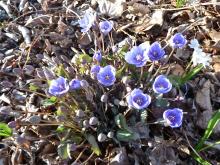
Re: Jeffersonia
Since our Jeffersonia are just lovely foliage now, good to again see the beautiful blooms. Wow, 26 C (77 F) is a warm day, you'll have plants and flowers popping all over the place. I'm amazed at just how fast plants can open flowers when they receive full days of warmth.
Re: Jeffersonia
Since our Jeffersonia are just lovely foliage now, good to again see the beautiful blooms. Wow, 26 C (77 F) is a warm day, you'll have plants and flowers popping all over the place. I'm amazed at just how fast plants can open flowers when they receive full days of warmth.
That never happens here!
The warmest so far was yesterday evening - had to use the garden parasol when we had dinner outside in the evening ;D ;D
Still, my sole Jeffersonia hasn't opened the flowers yet.
Re: Jeffersonia
I saw this link on an SRGC post that shows a very full-flowered form of J. dubia similar to Rick's fine form:
http://www.srgc.net/forum/index.php?topic=9018.msg245568#msg245568
http://www.srgc.net/forum/index.php?action=dlattach;topic=9018.0;attach=...
Re: Jeffersonia
Yes, a very nice one. It seems to have almost exactly the same form, except that I don't see any of his flowers with more than six petals.
But unlike mine, I'll bet his is fertile...
Re: Jeffersonia
Yes, a very nice one. It seems to have almost exactly the same form, except that I don't see any of his flowers with more than six petals.
But unlike mine, I'll bet his is fertile...
Rick, are you sure yours is completely sterile? Sometimes "sterile" plants can produce some good pollen. But you probably have to try several times . . . . . .
And you can try colchicine treatment!
Re: Jeffersonia
Rick, are you sure yours is completely sterile? Sometimes "sterile" plants can produce some good pollen. But you probably have to try several times . . . . . .
And you can try colchicine treatment!
Actually, I haven't had too much opportunity to try using pollen from the double plant on a normal type. It is in a part of the garden where it blooms much later than the other. Bloom times often don't overlap. Saving pollen from a normal one is easy to try to pollinate the double, but vice versa is is more difficult. I've only tried it once without success. What I ought to do is grow some seedlings next to the double one...
Re: Jeffersonia
Seedlings of J. diphylla are growing lustily, now I'm worried about being able to make a new woodland bed large enough to hold them all, the start of my "Jeffersonian woodland lawn". In the overhead view (photo 1), you can see equally full flats of J. dubia in the back (center and to the left).
Re: Jeffersonia
to have such a worry is the dream of many a gardener...
Good show! ;D
Re: Jeffersonia
Seedlings of J. diphylla are growing lustily, now I'm worried about being able to make a new woodland bed large enough to hold them all, the start of my "Jeffersonian woodland lawn". In the overhead view (photo 1), you can see equally full flats of J. dubia in the back (center and to the left).
Like Rick, I wouldn't worry much! BTW, are the seedlings easy to plant out or do they sulk afterwards?
Re: Jeffersonia
Like Rick, I wouldn't worry much! BTW, are the seedlings easy to plant out or do they sulk afterwards?
They're easy as dirt ;D All kidding aside, they seem indifferent to being handled and transplanted.
By the way, an interesting thing about both Jeffersonia and Epimedium seed, I kept some flats where I received no germination, and in the 2nd year, a few additional seedlings showed up. I was most disappointed last year when seed of white Jeffersonia dubia (kindly sent to me by a SRGC correspondant) showed zero germination. I held on to the flat, and this year, a single seedling appeared!
Re: Jeffersonia
Those flats of Jeffersonia seedlings are pretty exciting to a nurseryman's eyes! Jeffersonia dubia was one of the first plants that hooked me on 'alpines' (from a picture in a book by Anna Griffiths), but we have never managed to grow it well - too dry I suppose. Those full flowered forms of Rick's and on the SRGC Forum are even more delectable, and also the striking variety Mark showed from Korea. There must be somewhere in the garden we could do better with them!
Re: Jeffersonia
Seedlings of J. diphylla are growing lustily, now I'm worried about being able to make a new woodland bed large enough to hold them all, the start of my "Jeffersonian woodland lawn". In the overhead view (photo 1), you can see equally full flats of J. dubia in the back (center and to the left).
I can really see how that would be a problem, Mark. :P If I didn't live on the other side of the ocean....I would have gladly helped you...A flat more or less for my garden wouldn't be a problem, still have a lot of lawn to convert to woodland beds ;D ;D :P
Re: Jeffersonia
Propagation non-results:
You may remember that I wanted to divide a particularly wonderful J. dubia specimen. Being apparently sterile, it's stems multiply vigorously, so I can easily afford loosing some.
When the leaves matured, I tried to cut six growing points off the side while leaving the plant undisturbed in the ground. I cut vertically into the soil hoping I would get some roots along with the stems. No dice. This outer group of stems seemed to curl in, just under the soil surface, toward the center of the plant. I think if I were to dig the the whole plant in the early spring (no, not going to do that!), the shape of the top of the plant would look like a mushroom, with a constriction below the crown, but "exploding" at the top with a multitude of pips. This is unlike the growth of a regular J. dubia nearby.
So I had four usable short stems, and stripped all but two leaves per stem. Then "planted" them in a vermiculite/peat mix, and enclosed them in a clear plastic bag in Nearing frame conditions. The extra leaves were so stiff and non-wilting, that just for kicks, I tried to see if they might root. I treated them as one might when rooting a tropical begonia leaf, with perhaps a centimeter stem, and the leaf laid flat on the vermiculite/peat surface, with the main veins cut with a razor blade. All other rooting parameters were the same.
Neither method was successful. But what was interesting to note was that the individual severed leaves actually lasted longer before withering than the stems!
Re: Jeffersonia
A pity it didn't work! Did you try rooting hormone?
Re: Jeffersonia
No I didn't, Trond. That is yet another avenue to explore. That and different times of the season.
Any thoughts on timing from anyone out there?
I forgot to mention on the pic of the cuttings you can see the withered flower stems if you you magnify the image.
Re: Jeffersonia
When I first got the white form of Jeffersonia dubia and it had bulked up quite well, I tried dividing it. It was a great mistake; the divisions sat still for ever. Perhaps I should have caught it just at the point the plant was beginning to grow. It sounds to me like a ripe plant for tissue culture if hormonal treatment is likely to stimulate proliferation of callus-like growth that can then be stimulated to produce shoots. It does sound as though it might be triploid. Maybe if it keeps growing strongly it would eventually be possible to get large divisions that are not checked too much, to allow a bit more experimentation.
Re: Jeffersonia
Rick, maybe best not to tempt fate, and leave your glorious plant alone and just enjoy it, and take lots of pictures for all to enjoy. I'm getting superstitious with some plants, worried that attempts to propagate will kill them.
I took a photo of the Korean Form today, to show a couple blooms that had dropped their petals and red pods are developing. I later noticed the pod and remnant stamens and anthers form an amusing face. Took another close-up shot, they look like little gesturing Jeffersonia monkeys ;)
Going back to yesterday's late afternoon photo, I didn't notice the "little guys", but they can be seen here too. I thought the lighting dramatic, showing up the Pulmonaria and red Corydalis solida in the background.
Re: Jeffersonia
I just came across this, a Japanese nursery selling seed of a variegated leaf Jeffersonia dubia, photo is very small (scroll down), but it looks quite remarkable.
http://www.yuzawa-engei.net/08English/02SeedsCategories/02Seeds.html
Sometimes I should look closer to home, here's a photo of Jeffersonia dubia color forms right here on NARGS wiki, in the garden of nearby Jan Sacks and Marty Schaefer:
http://nargs.org/nargswiki/tiki-browse_image.php?&imageId=4248
Re: Jeffersonia
I can recommend the nursery Yusawa-engei. I have ordered both plants and seeds from them. The plants travel all the way from Japan to Norway in very good condition!
Although the flowers of Jeffersonia are ephemeral they (both species) are indeed worth a place in a garden! The leaves are decorative too.
I have a small batch of seedlings now waiting for planting out later ;D
Re: Jeffersonia
Those developing seed pods bring a whole new personality to the plant! Very nice pictures on the Wiki - I'm not so sure about the 'variegated' plant, but interesting that this is transmitted via the seed. It be good to try and multiply Rick's plant because if it is completely sterile I imagine the flowers last much longer than normal Jeffersonia; normally they are so beautiful, but so fleeting.
Re: Jeffersonia
The long cold spring, and sudden change to warmer weather, has brought out plants all over the garden, and this white Jeffersonia is definitely one of the loveliest...
Re: Jeffersonia
Thanks for the update Rick- I've posted a link to here from your
thread on the SRGC Forum from last year. :)
Re: Jeffersonia
Tim, I'm envious of your beautiful white Jeffersonia dubia. Seeing this I ran outside to check the spot where I planted the single seedling last summer, nothing showing yet. Not sure if I kept it moist enough after planting it out under the canopy of hemlock trees, the hemlocks tend to block rain from reaching the ground.
Re: Jeffersonia
All the colours are great :)
Interesting nursery too! Wondering about timing- Jeffersonia and Dicentra are warm/cold/warm germination, right? So the time to buy/sow would summer?
Re: Jeffersonia
All the colours are great :)
Interesting nursery too! Wondering about timing- Jeffersonia and Dicentra are warm/cold/warm germination, right? So the time to buy/sow would summer?
I find jeffersonia seeds are very short lived and always sow straight from the pod the day it ripens. It then germinates the next spring.
As to dividing plants the only one I tried by cutting in two died at once,on the other hand I have a plant of the white form which was propagated by division for me, so it could just be my lack of skill.
Re: Jeffersonia
I find jeffersonia seeds are very short lived and always sow straight from the pod the day it ripens. It then germinates the next spring.
When I collect seed of Jeffersonia, Epimedium, and woodland Iris species, I collect directly into plastic baggies. They can stay in the seed for up to 2-3 weeks without problem, and then sown, to germinate next spring; just gives a bit of leeway as to when the seed is sown.
Re: Jeffersonia
Over the years people have toyed with the idea of a short viability seed exchange because there are so many woodland plants in particular like this: seed could be kept in slightly damp vermiculite for a long time if necessary. A few growers do supply seed like this in the UK, and occasionally Society seed exchanges institute the idea, but there are probably not enough knowledgeable gardeners to really make it viable (excuse the pun). Similar, but different, is supplying seed that has been pretreated (eg: by cold stratification) to improve germination, and the German seedsmen Jelitto must be pre-eminent in this. Years ago I remember getting some rosulate viola seed that had been stored moist in the cold and it gave very good germination - growing them on was another problem!
Re: Jeffersonia
If I read correctly, the Japanese nursery noted above is selling seed of this sort moist packed, as Kristl does, which seems to preserve them for some time- until sown if the same season, or if it's a bit later, the moist packing seems to take the place of the warm period in warm/cold/warm, so they can go straight to cold.
Just curious about how well these (and Dicentras I was especially looking at on that list ;D ) respond to moist packing..
Re: Jeffersonia
I'm not too familiar with how long you can moist pack seed before they'll start germinating on their own, or rotting... Kristl Walek would know.
I neglected to post this season's best photos of Jeffersonia dubia Korean Form, so here they are. Still in bloom now, after 9 days, but the photo shown on the left was taken on about day 4 (in the sun) and the photo on the right taken on day 6 (cloudy).
Re: Jeffersonia
Yes, best photos indeed, Mark!
I get almost as much enjoyment with my failures as with successes, especially when it comes to seeds. When you said,
I'm not too familiar with how long you can moist pack [Jeffersonia dubia] seed before they'll start germinating on their own, or rotting
I may be able to provide some tangential experience. Through more happenstance than planned and methodical regiment, this is my unofficial, non-scientific, and inconclusive experience so far with a particulaar batch of dubia seeds. Take from it what you will. Edit: I thought these were Jeffersonia, but they are actually Allium triccocum
June 2011: collected J. dubia Allium triccocum seeds from my own plant.
Immediately placed between moist paper towels at 65-80F. (I don't have air conditioning).
They plumped even more into very dark, round balls.
August: the moist towels dried somewhat, to the point that a visible shrinking could be seen with the seeds.
After re-wetting, they returned to there previous size.
October: still no germination. Placed in fridge.
February 2012: Brought 65f.
May: Still no germination. Placed back in fridge.
September: After forgetting about them, I took half the seed and planted them. These are now spending the winter (and spring, if it ever comes) outside. The other half is still in the fridge. They look unchanged, still plump and still very firm. This is a photo of them now:
April 2013
Re: Jeffersonia
It's like Schrödinger's cat - they are either dead or alive; and you can't know before something happens ;D
Re: Jeffersonia
Rick, I'm really surprised those didn't germinate in the spring. I've always sown Jeffersonia seed (the few times I've got much) in pots as soon as I collect it, but with other such plants I have put moist-packed seed in an airing cupboard and then sown outside for the normal winter cold. It could be they really need constant percolation of moisture throughout the winter to allow germination to proceed. I think the ideal must be to sow fresh in pots in a cool place so they experience as close to natural conditions as possible. I like Mark's idea of sowing directly in the garden, except this isn't so effective for the nurseryman.
Re: Jeffersonia
Tim, I'm not sure why you didn't get germination. On Jeffersonia, this is one that typically don't do my scratch-and-sow-in-place technique (although one year I experimented with that too), I typically collect the seed and then within a week or two, all gets sown in peat flats and covered with wire to keep chipmunks from eating the seed (they love em). The flats sit on the ground in contact with the earth, and get sprinkled regularly. In spring, they germinate with such vigor that they tend to left the crust of soil up as a layer. I've done this with both species the last three years, and have gotten consistently strong germination, and always with diphylla being the slightly slower germinator.
One year as a test, I prepped an area approximately 4' x 5', and sowed the seed in place (immediately after seed was ready). Also had tremendous germination, but after 4 years, with animal trampling (an occassional deer passing through), mole tunneling, and other invading plants, it's not a sheet of Jeffersonia. But the area still has LOTS of Jeffersonia seedling plants there, growing in clusters or small colonies, this year small plants flowering in significant number.
Re: Jeffersonia
Oh the HORROR !!!!!
My most excellent J.dubia has been eaten. Eaten alive!
Dang varmints! This part of the garden is the last to thaw, and when I did my initial garden cleaning, all the old petioles had been severed, just as mice do with lawn grass over winter, and all the buds gone. :'(
27 April 2013
You can see a few buds left at the outer edges, where they would have been a little under and hidden.
Thankfully, a few more have emerged also, and all is not lost.
8 May 2013
PHEW !
Re: Jeffersonia
OMG Rick, that's terrible! :'( I shed Jeffersonian tears for this sad development.
It seems that when there's just one of something, that's when something happens to it. At least there's new shoots coming up at the periphery, and hopefully it'll rejuvenate to some level. Depending on it's level of renewed growth, maybe it would be prudent to attempt a division, just so that you have more than one plant in the garden.
Dang varmints!!!
Re: Jeffersonia
Sorry to hear, Rick, hopefully there is enough left underground to regenerate..
This is a very long thread on
This is a very long thread on Jeffersonia!
Having just set the moist packed seeds out for a winter sowing.
Thanks for all the information of this thread.
[quote=Hoy]
It's like Schrödinger's cat - they are either dead or alive; and you can't know before something happens ;D
[/quote]
Something happened !!!
So to catch up on what had previously been going on with the Jeffersonia Allium triccocum seed I harvested in 2011, you can look at an earlier post in this thread here: https://www.nargs.org/comment/4409#comment-4409
Since then (April 2013), I just left them alone, kinda as a lost cause, and they stayed in their moist paper towel in a closed container and on a table next to the outside wall of the house. They endured temps of 80 plus degrees F in summer, and temps as low as 45F nights this winter. In early December there was still no activity. But now...
The cool temps finally triggered germination, as normal. I suppose that after the seeds' initial hydration, the drying up in 2011 must have put it into a very deep dormancy.
Incidentally, there are still three dormant seeds.
So now more investigation and questions....
I had assumed that with this kind of germination mode,
--- first a root would grow
--- a crown would establish
--- then the first true leaf would emerged from the crown
This is not right then, if I assume that the dark green part is a developing leaf. Does anyone have any insight?
It appears there is a secondary root growing here, possibly indicating where the crown is....
Wow, well done, Rick! Right
Wow, well done, Rick! Right there is a demonstration of the wisdom of hanging onto planted seeds that haven't germinated... a lesson I need to follow.
Rick, those seedlings do not
Rick, those seedlings do not look anything like dicotyledons?
How are they now?
I planted most of them, but
I planted most of them, but kept a few for further examination. Not really much change yet, but I have a little better pics. It’s the limit of my pocket camera. Every seedling has grown a secondary root. I cut one of the ungerminated seeds as shown in the second pic. The seed was still surprisingly hard. Vertical marks are millimeters.
Cool pics Rick, thanks for
Cool pics Rick, thanks for sharing those.
Rick, seems the one you cut
Rick, seems the one you cut still was alive with a small embryo. But it doesn't look like a dicot though!
I had no doubt the seed was
I had no doubt the seed was still alive. I cut it because I thought I would easily see the two cotyledons. But that's certainly not the case!
I suppose only time will tell. It was all so long ago, I won't even venture a guess of what else the might be.....
Yow, it came back to me, and
Yow, it came back to me, and am I red in the face! I try hard to keep the best records, but as many will attest, things still manage to fall through the cracks.
I am almost positive that they are wild Allium triccocum seeds I collected near here that same year. At least the mystery is solved.
I had wondered what happened to them....
Now I am wondering what happened to the real Jeffersonia dubia seeds!
Have you looked in the fridge
Have you looked in the fridge, Rick?
Look what I found this spring
Look what I found this spring! Beneath my special multi-petaled Jefersonia dubia are two seedlings! My other seed producing J. dubia is 25ft away. Ants carry the seeds even that far away, but always to warmer, drier areas. This more moist area gets no direct sun, except late in the day, so I am very hopeful! Still have never found any seed capsules on the "mother" plant yet, though. I wonder about the seedlings' true origin with fingers crossed!
Isn't this interesting....
Isn't this interesting.... from http://english.knps.or.kr/flash/resources2/Model/knpsPicture_XML.xml
Jeffersonia dubia
RANUNCULALES Berberidaceae
Status : No data / No data
It is perennial. The unit stem does not exist and several leaves come from the root stem. The leaf is a rounded heart shape, the length and width are 9cm and the boundary is wave-shaped. The flower is red-purple. It hangs on the stem of the flower from April to May. The fruit is widely oval-shaped as a follicle. It propagates by seeds, but plant multiplication by separating the roots is done as well. It grows on the bottom half of mountains. It grows in nationwide in Gyeonggi-do, Gangwon-do, Chungbuk, jeonnam, Gyeongnam and Gyeongbuk and is also distributed in Amur and Usuri, Russia and northeastern china.
※References
Korean red data book(MOE, UNDP/GEF Korea Wetland Project, NIER)
Good find Rick (on both
Good find Rick (on both accounts; the appearance of a couple seedlings on your fine form, and the information on this species in Korea). For me the link doesn't work (in Firefox), it displays as a raw XML page, but I went to the root web page, and after bumbling around for a while, found a beautiful picture of Korean form of Jeffersonia dubia with the classic red ovaries; here's the direct photo link:
http://english.knps.or.kr/down/chi-Jeffersoniadubia.jpg
Mark McD wrote:
[quote=Mark McD] For me the link doesn't work (in Firefox), it displays as a raw XML page[/quote]
Me too (on FF), but when I copied it to the forum, it processed the code, and voila!
That's a wonderful Korean Jeffersonia pic. Are they really that small, or the brown forest floor leaves that big?? What about yours, Mark?
NIce find, Rick. I've been
NIce find, Rick. I've been amazed to find seedlings all around my Jeffersonia dubia this spring - never noticed any before except directly under it; must be the crazy winds blowing them around - and have been busily moving the seedlings around!
I had a surprise this year
I had a surprise this year with Jeffersonia diphylla seeds. Usually there are so many that I have trouble with too many seedlings, even after harvesting as many seeds as possible. I won't be bothered with seeds this year -- a very industrious rat picked off almost all the seed pods, heaped them in neat piles, and chowed down! Thankfully my two terriers helped put an end to his gourmet snacking.
I was able to share only a few J. diphylla seeds. J. dubia bloomed and set seed earlier, so its seed harvest was not affected.
Some of the seedlings grown
Some of the seedlings grown from seed you sent me, Mark. Most of them are going to flower for the first time this year.
Jeffersonia diphylla
RickR wrote:
[quote=RickR]
Some of the seedlings grown from seed you sent me, Mark. Most of them are going to flower for the first time this year.
Jeffersonia diphylla
[/quote]
Lovely clear detailed photos Rick.
That's good new Rick. I'm
That's good news Rick. I'm amazed that with our 9' of snow, which finally cleared out of the yard about 1 week ago (April 10, 2015), that my J. diphylla plants are at the same stage of emergence as yours! It's such a great plant, rather fleshy and distinctive when emerging from the cataphylls. I agree with Dave, good photos.
I have some 2nd youngsters
I have some 2nd year youngsters coming along ,courtesy of seed from a Forum member however to my shame I've lost the donor's details ![]() ...I'd like to blame it on ' too many species not enough time '
...I'd like to blame it on ' too many species not enough time ' ![]() .........
.........
>>>Lovely clear photos
>>>Lovely clear photos
Thanks. I actually chose to show the ones with better bokeh over full detail!
More pics, two days later:
Here's a photo from the peak
Here's a photo from the peak of bloom back on April 22. Now, the seed pods are visible and the plants are beautiful mounds of foliage (although snow-covered today, ahem). I'm glad to see that the seedlings I distributed around last year are coming up.
Here's what they look like today, with just foliage (except for the odd flower hidden deep in there) and seedpods;
That J. dubia has certainly
That J. dubia has certainly outdone itself this season, Lori. As I recall, you were always hopeful that it would one day "break out".
Update on the J. diphylla seedlings.. Pic from May 1.
They took off in 2012, with
They took off in 2012, with enough flower density to make an impressive sight. Terrific plant! I'm pleased that the seedlings I moved around last year have come up, too.
But that reminds me, I had J. diphylla somewhere... must go check on it tomorrow. Very well done with the seedlings!
How did you germinate these?
How did you germinate these?
Oscillating cold/warm cycles?
I have them out in an unheated garage?
When someone sent me fresh
When someone sent me fresh seed in late June, I immediately scratched them into the soil, about 3mm deep.
They sprouted in early May.
Caroline, look here:
Caroline, look here:
https://www.jstor.org/stable/2444529?seq=1#page_scan_tab_contents
It's really easy to set up a free account, and read the papers for free, just click the "Read on line" button, and go from there.
RickR wrote:
[quote=RickR]
Caroline, look here:
https://www.jstor.org/stable/2444529?seq=1#page_scan_tab_contents
It's really easy to set up a free account, and read the papers for free, just click the "Read on line" button, and go from there.
[/quote]
Thanks for the link Rick! I signed up, the free version allows adding up to 3 articles ( for reading only) to one's "bookshelf" for 2 weeks, after which they can be removed and new articles added . One can make screen captures of each page of an article as a workaround, for future reference.
The curious thing about the Jeffersonia germination article, a couple times they say there are 4 species (!) but only mention diphylla & dubia; there are a few published names of other Jeffersonia species but considered by The Plant List as synonyms or having "unresolved status". One thing learned from the article, is that 3 summer months of warm stratification is needed for the embryo to plump up by autumn, for successful germination the following spring, confirming the need for immediate sowing when seed is ripe.

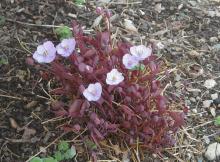
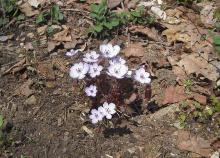
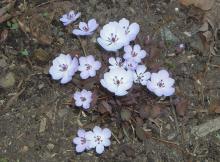
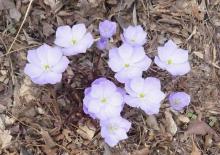
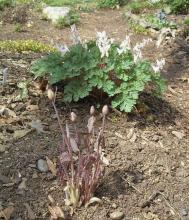
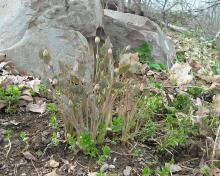
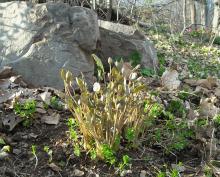
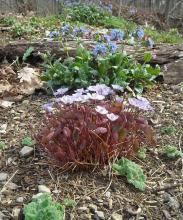
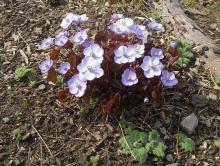
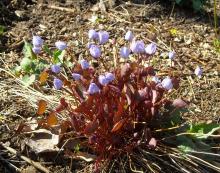
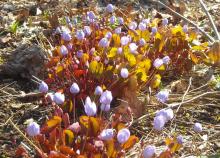
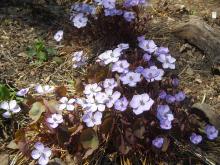
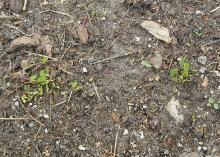
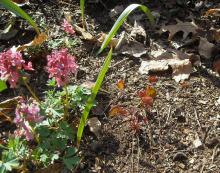
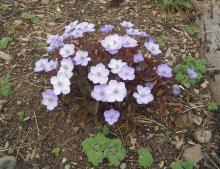
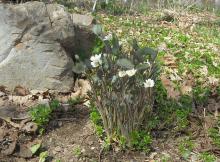
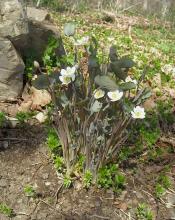
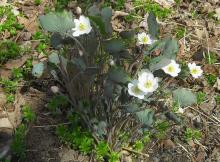
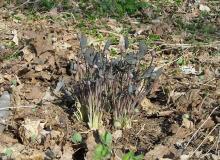
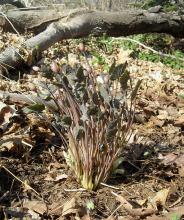
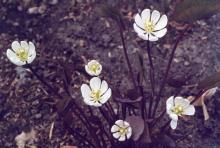
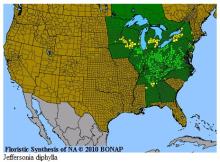
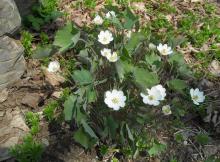
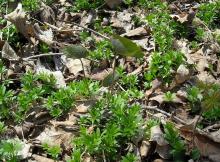
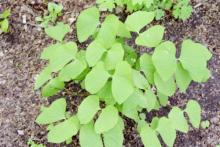
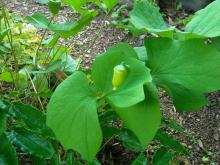
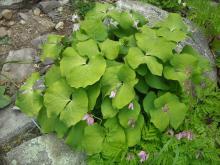
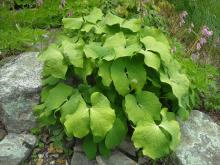
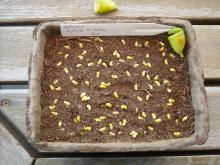
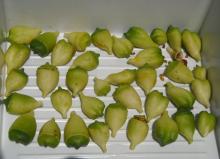
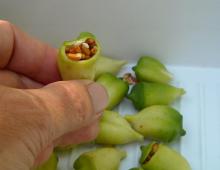
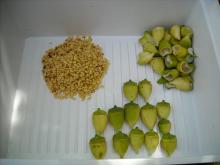

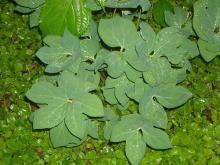
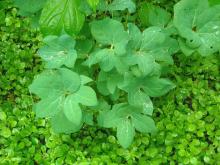
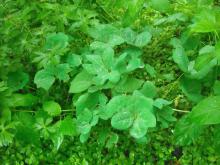




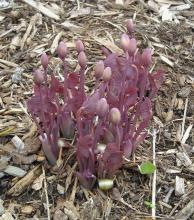
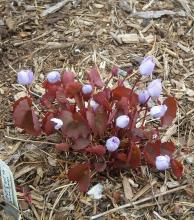
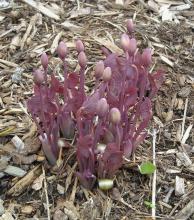
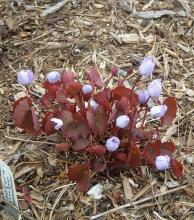
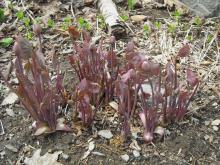
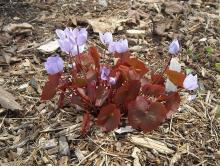
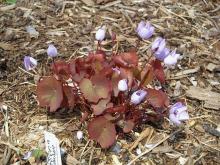
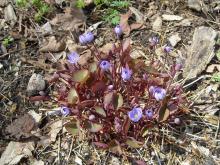
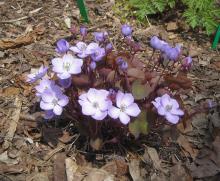
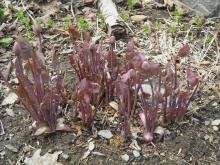
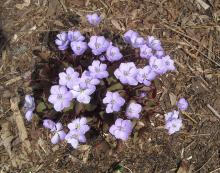
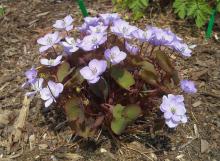
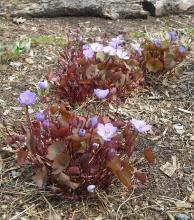
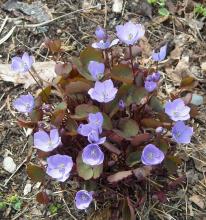
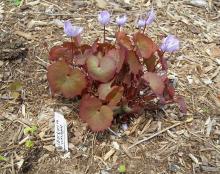
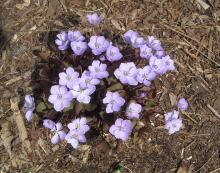
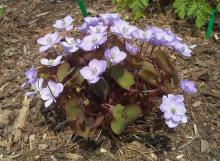
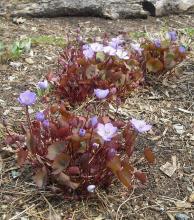
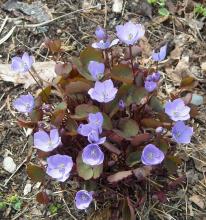
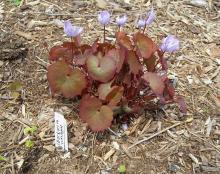
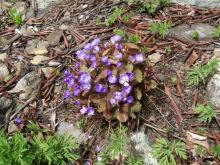
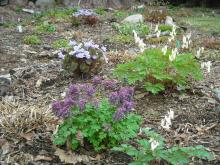
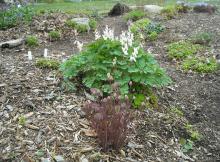
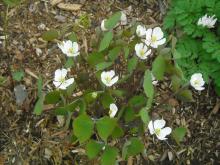
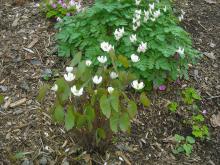
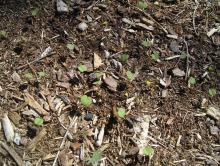
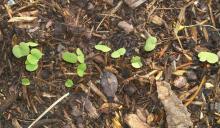
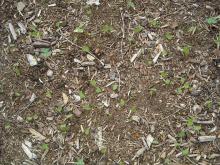
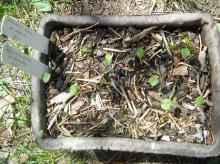
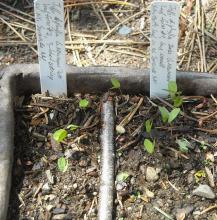
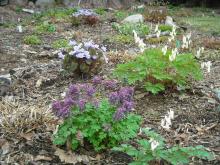
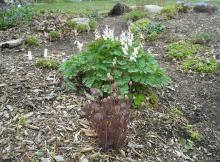
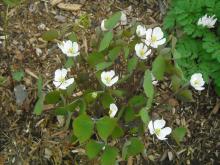
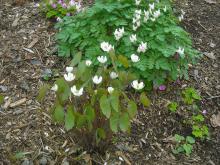
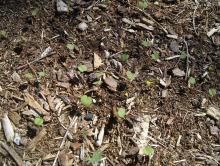
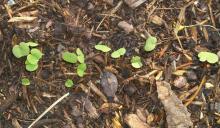
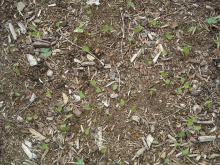
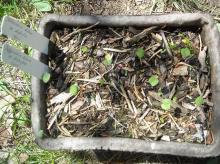
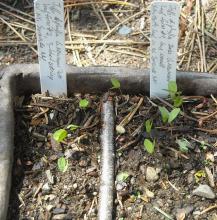
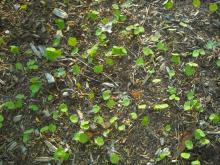
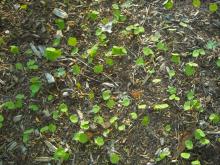
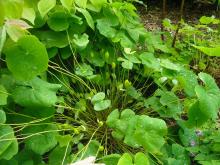
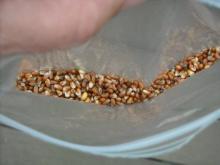
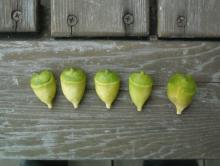
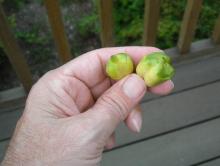
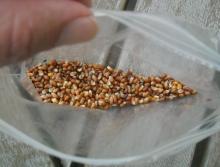
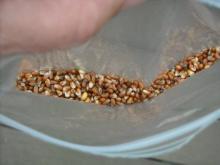
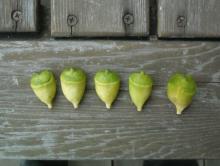
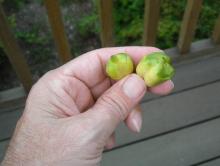
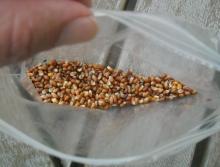
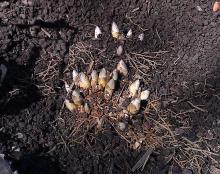
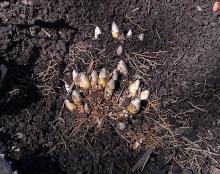
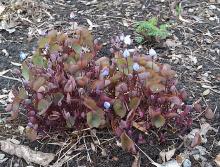
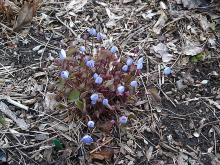
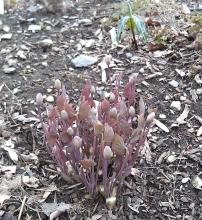
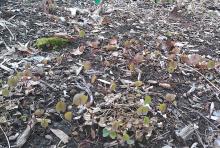
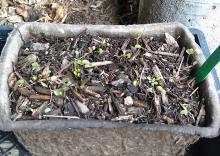
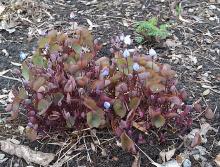
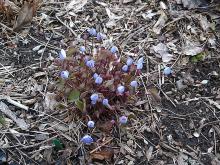
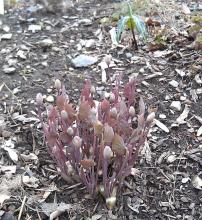
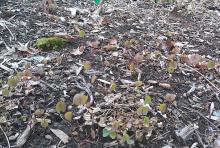
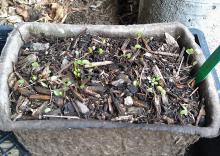
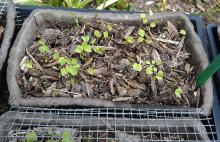
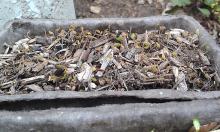
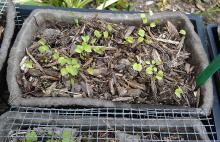
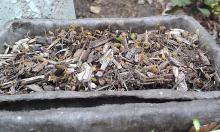
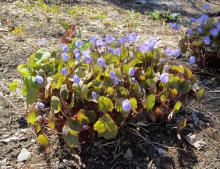
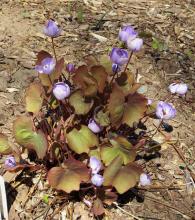
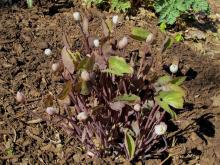
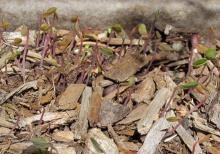
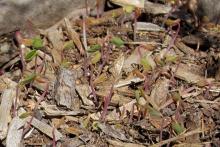
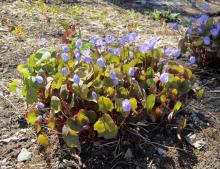
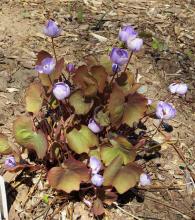
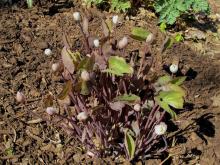
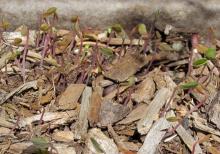
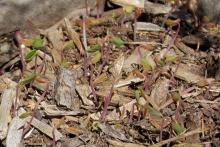
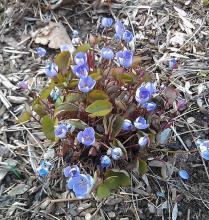
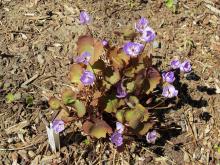
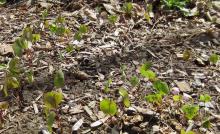
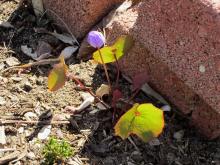
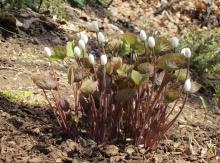
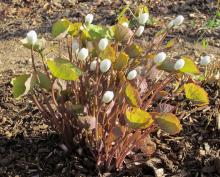
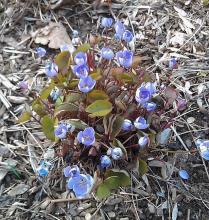
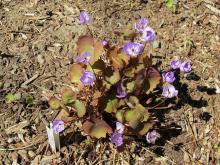
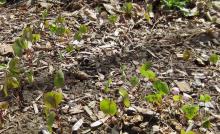
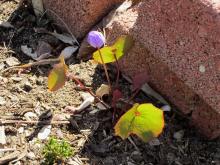
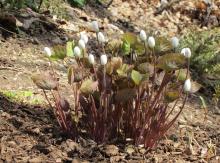
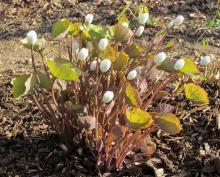
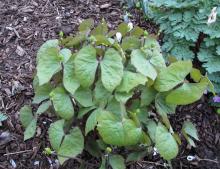
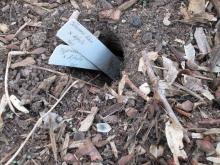
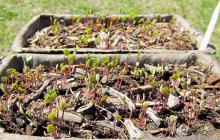
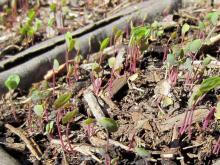
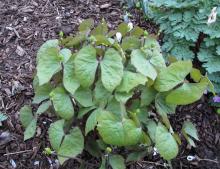
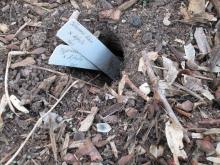
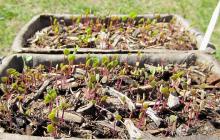
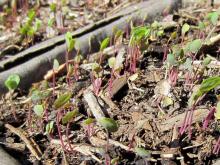
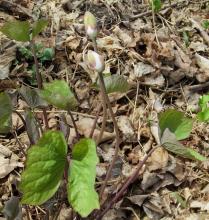
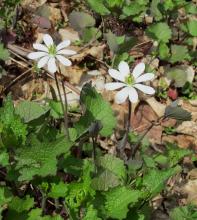
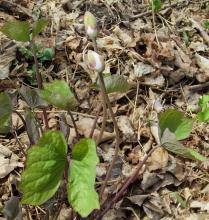
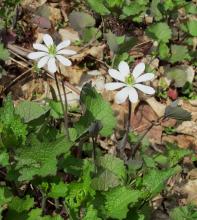
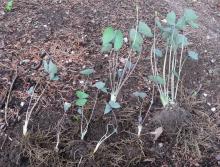
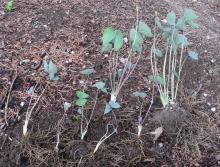
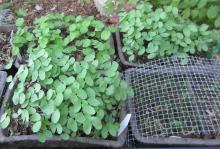
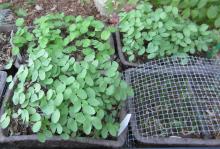
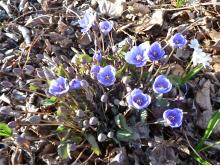
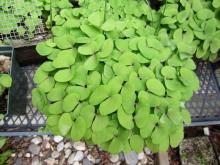
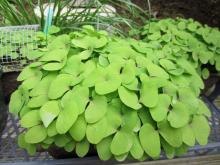
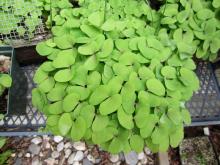
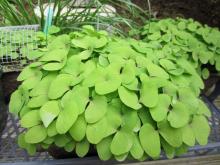
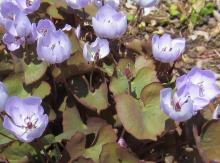
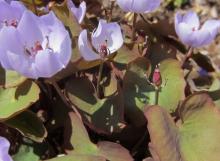
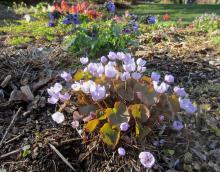
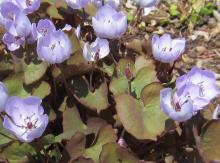
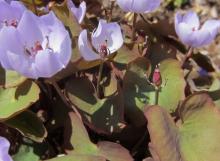
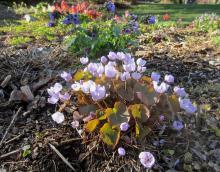
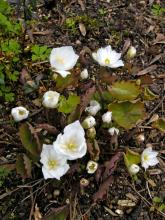
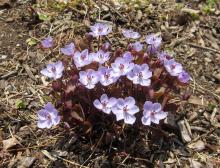
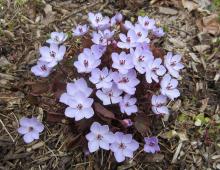
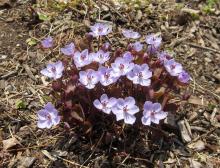
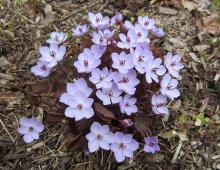
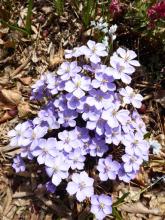
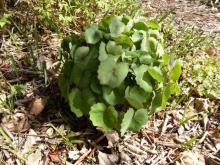
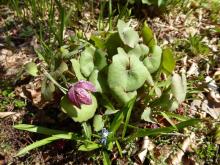
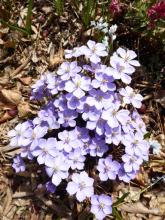
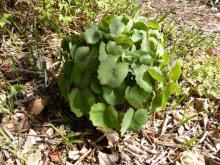
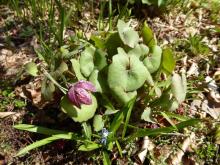
A 2009 "normal" J. dubia with a few extra petals. I like the variation of leaf form whthin the species too. I use a perhaps better quality, but still a point and shoot camera - a Lumix TZ4. It has an exposure setting I have since learned to used to my advantage for light color rendition. I'll bet the Coolpix has something similar. In fact most of my flower pics are now taken with an exposure of minus .5 to minus 1.
The second pic is the same plant today. I guess it really likes where it is. The anticipation is killing me.